Visiting Barcelona in Winter
36 min readBarcelona in winter is a busy city with lots of things to do. This beloved city is the perfect European destination for a winter escape and to indulge in some soft, warm winter sunshine while enjoying the cultural highlights, mountain visits and the incredible cuisines.
Read this comprehensive guide before you go. I share the best sights and top tourist attractions in Barcelona in winter that are worth your time the most.
The post Visiting Barcelona in Winter appeared first on Timeless Travel Steps.
Considering visiting Barcelona in the winter and wondering what to do in this lively city? If so, I am glad you are here.
In this article about the best things to do at Europe‘s largest metropolis on the Mediterranean coast, I share my experiences and practical tips to help you figure out what is best for your winter trip to Barcelona.
Why Visiting Barcelona in Winter is a Great Option
Visiting Barcelona in winter can be a great option. Barcelona enjoys relatively mild winter weather compared to many other European cities, with temperatures typically ranging from the 10-20 degrees Celsius (50s to 60s Fahrenheit). If you don’t mind cooler weather and are looking for a more relaxed and budget-friendly visit with fewer crowds, then it’s worth considering. Just be prepared for some potential rain and shorter days, but there will still be plenty to see and do in this vibrant city.
Barcelona is an excellent European city holiday destination in the winter and for good reason. While it does not offer winter activities such as skiing, you will absolutely love the city vibes, lively scenes, the splendid architecture, the museums, and the incredible cuisines. Barcelona has a seaside too which is great if you want to combine a city visit and a beach vacation.
With so many popular attractions and things to do, deciding on what to do is indeed not an easy decision to make. To help you figure out where to go and what to see, I share the best sights and top tourist attractions in Barcelona during winter that are worth your time the most.
Timeless Travel Steps is supported by our readers. If you purchase through an affiliate link on my site, at no cost to you, I may earn a commission from qualifying purchases. Please read our Disclosure.
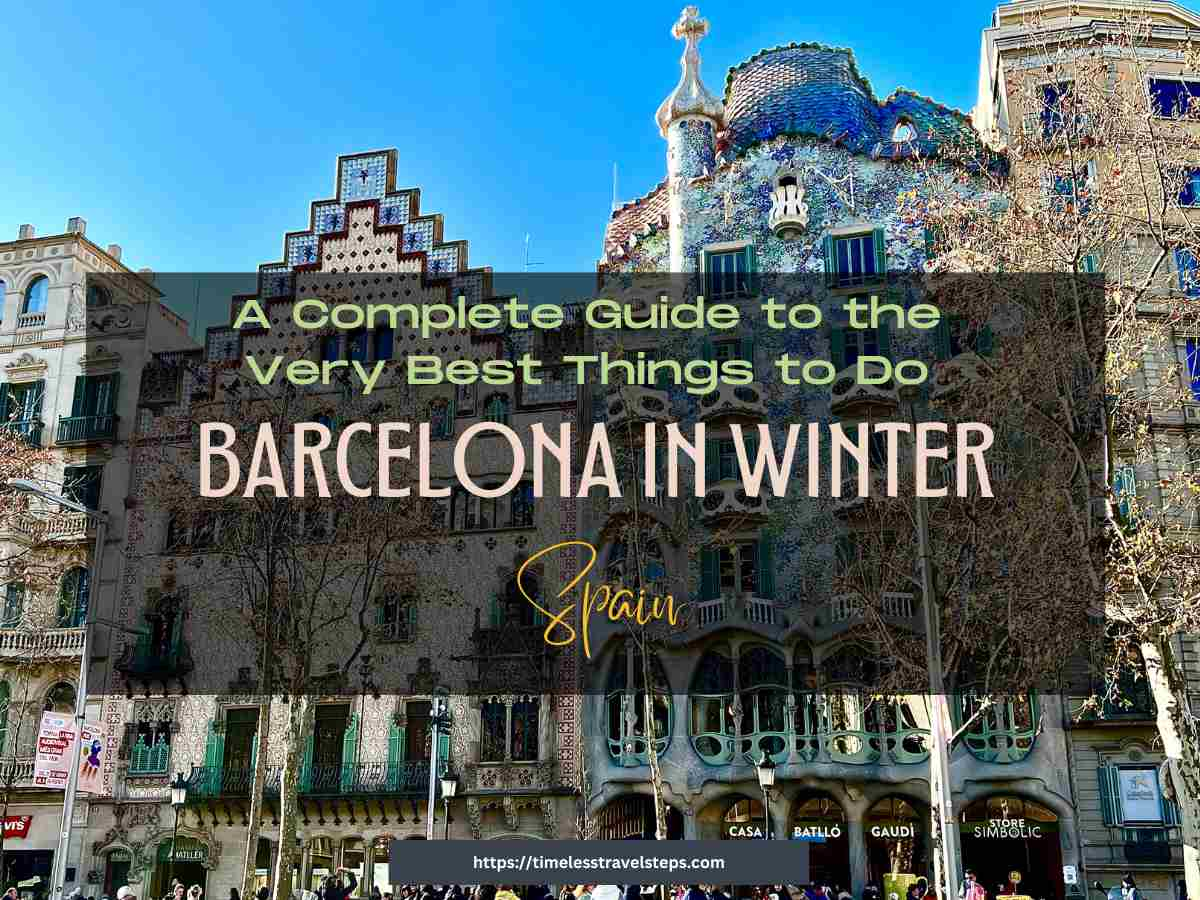
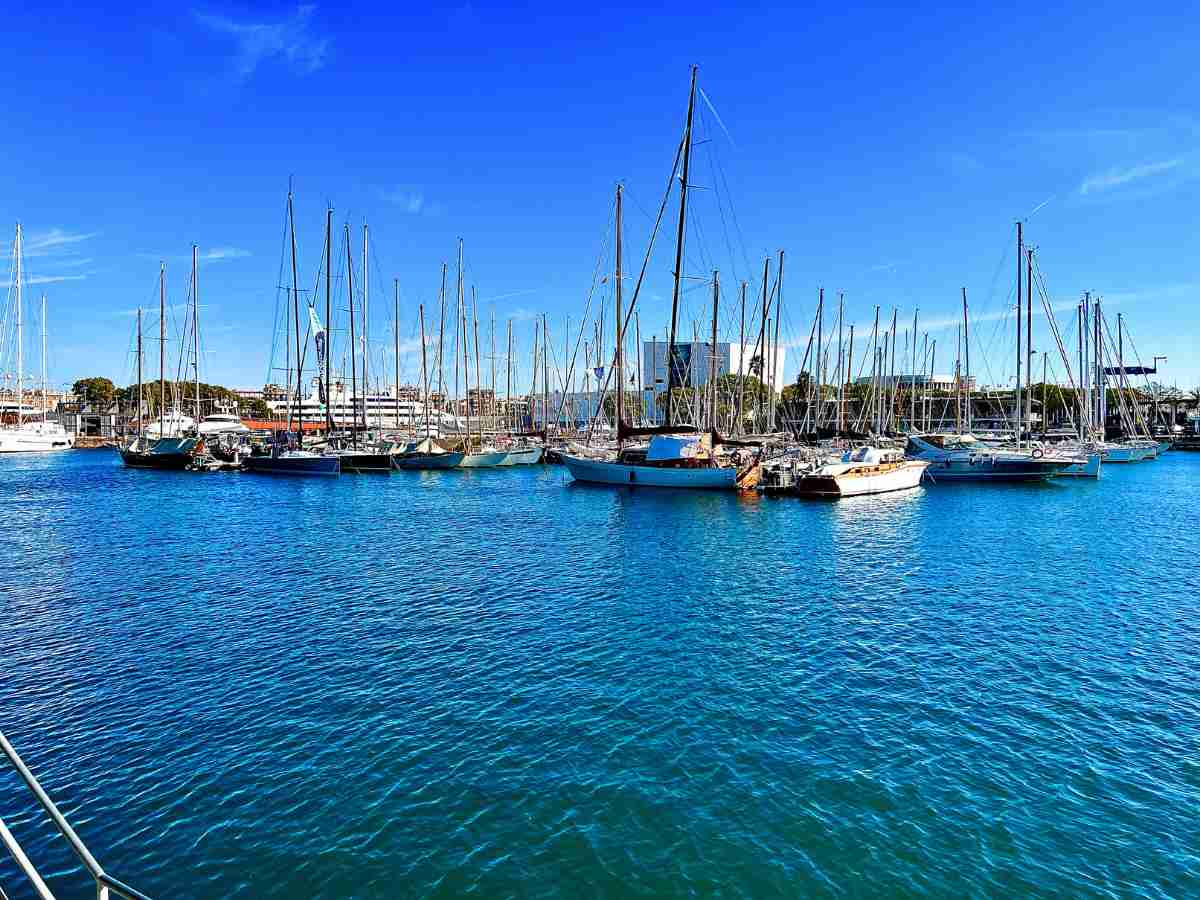
My Winter Escape to Barcelona, Spain
I visited Barcelona a few years ago for an extended holiday. We did a road trip from Barcelona to Costa Brava, along the coast all the way to Costa Daurada with trips to Port Aventura and the coastal towns. It was an incredible experience.
I was more than happy to return recently to Barcelona. I don’t usually like to leave the comfort of home in January but was convinced to an extended weekend away which I couldn’t refuse. Besides, the weather in the UK has been unusually cold and the weather in Barcelona during winter is surprisingly warm and sunny.
Barcelona turned out to be a perfect winter escape for me. Mild temperatures, gentle breeze, no rain and warm winter sunshine. I enjoyed meandering through the city streets, taking time to admire the stunning architecture. The lively culture that makes Barcelona one of the most beloved cities in the world was not amiss. This culturally diverse city of Europe does not disappoint.
As our visit to Barcelona was in January, we did not experience any of the festive-related activities. I’d suggest that the crowd was much less than one would expect in December during the festive season. Barcelona in January was still a busy city with so many things to do in winter.
In this article I share all of the highlights of Barcelona which you could experience on your trip along with my experienced tips, so nothing is missed during your visit.
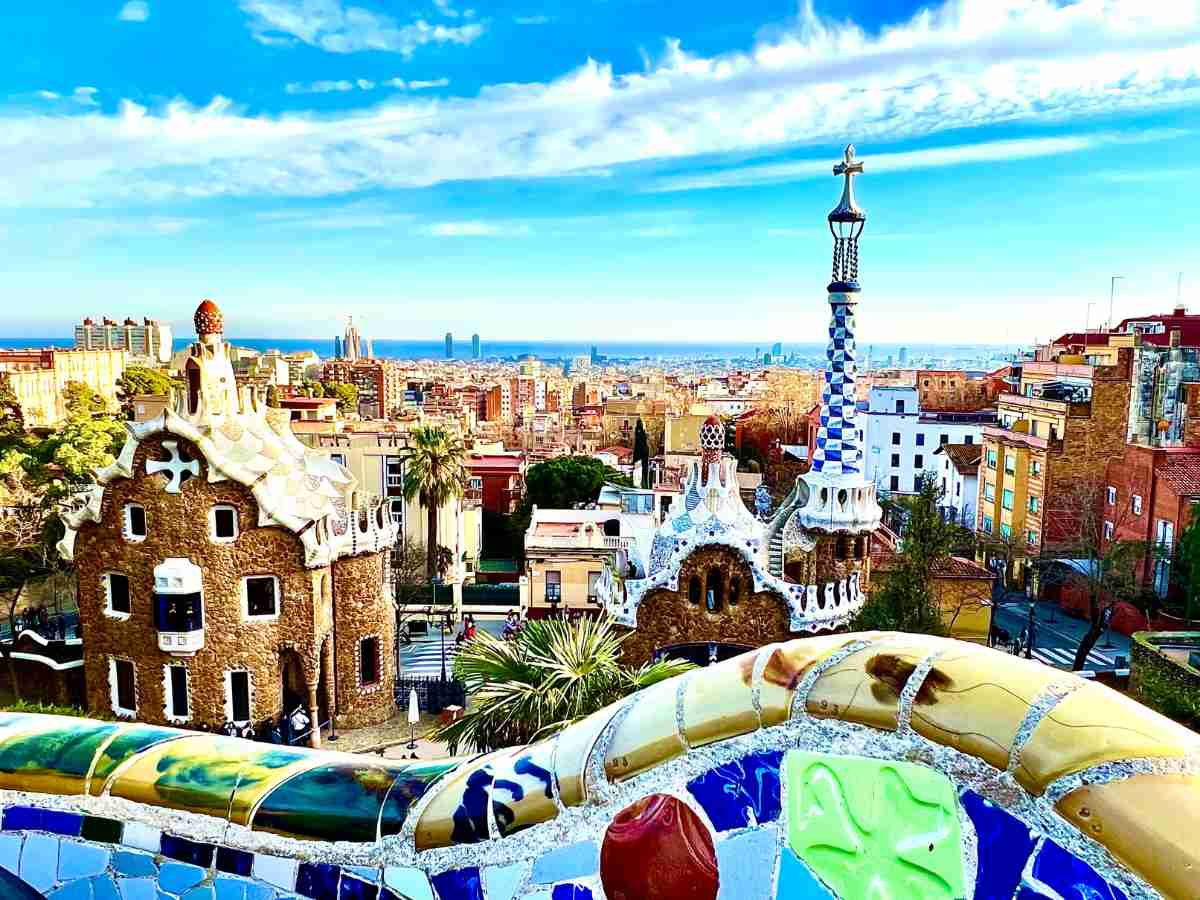
About Barcelona, Spain
Barcelona is the capital of Catalonia. Located in the northeast region of Spain and overlooks the Mediterranean Sea. This stylish cultural city is famous for Gaudi and other Art Nouveau architecture also. Barcelona is one of the trendiest cities in Europe, a city that has provided inspiration to generations of artists, writers and dreamers alike.
Like its Andalusian cousin, sultry Seville, this sun-drenched destination has something for everyone to enjoy in winter. Home to many renowned museums, churches, parks and beaches, there is no shortage of experiences to create lasting memories.
Immerse in the incredible showcase of modern and contemporary art at the MOCO Museum, take a stroll through the historical streets and enjoy the spirited atmosphere of Las Ramblas Barcelona — you will love it!
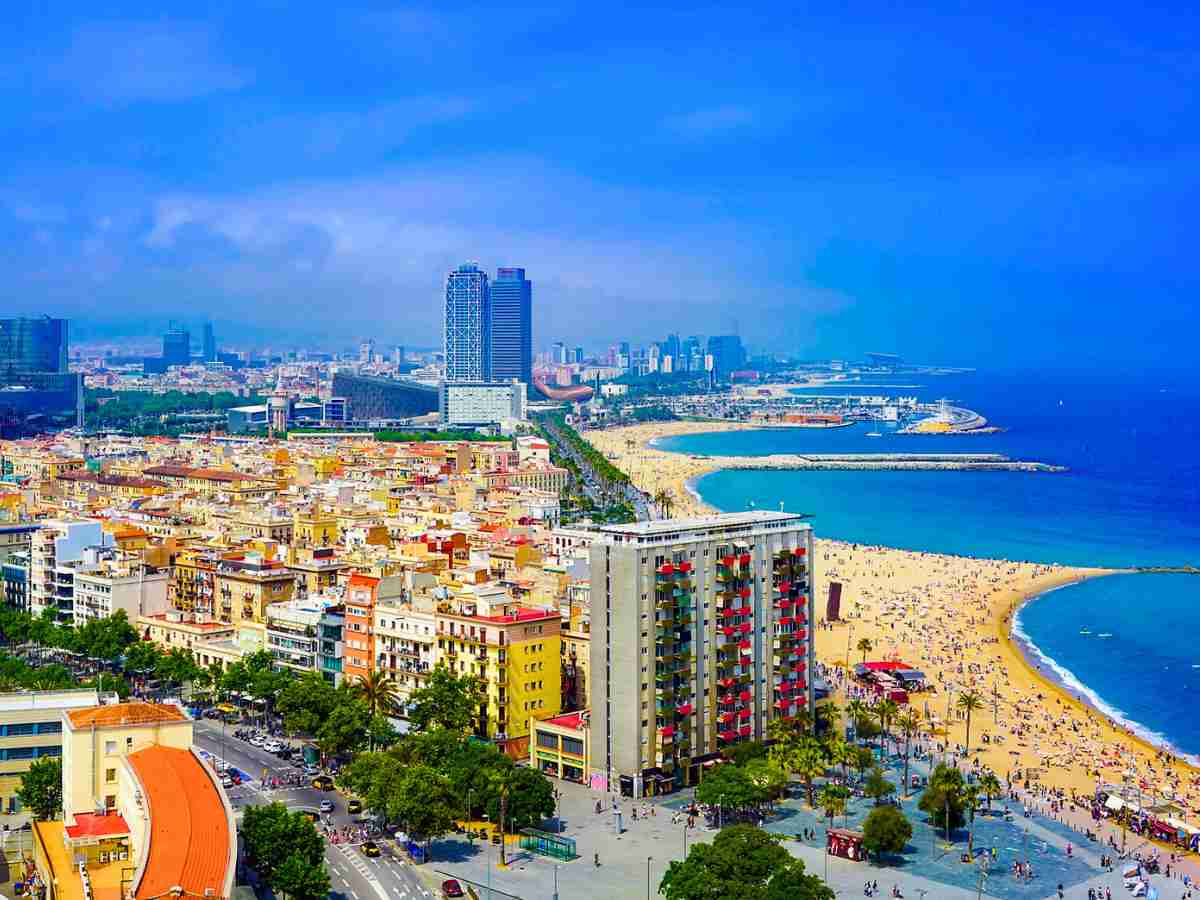
Barcelona in the Winter: Winter Weather in Barcelona
Barcelona is often referred to as the “Sun City” due to its temperate climate and year-round sunshine. Winter, however, does bring a chill to the city, making it an ideal destination for those looking to get away from the colder temperatures elsewhere. While temperatures can drop to as low as 4 °C (or 40 °F) during the winter months, the days are usually mild and sunny, providing plenty of opportunity to enjoy all that Barcelona has to offer.
Very Best Things to Do when Visiting Barcelona in the Winter: An Overview
Barcelona is an extraordinary city filled to the brim with stunning places and fantastic cultural experiences. When the winter chills sets in, Barcelona transforms into a unique wonderland of art, nature, and gastronomy.
Barcelona in the winter offers you many exciting activities to keep you busy and entertained. This guide encompasses the best sights and attractions, and the must-sees. Start with the top of the list and work your way down to suit the amount of time you have in the city.
This guide about Barcelona in the winter gives you an insight into what to expect when you visit this grand city of landmarks. There are plenty of tips and advice to help you make the most of every minute of your stay here.
In addition to must-sees, Barcelona has many more interesting and fun things to do. While it may not be possible on a short visit, these experiences will make your stay more special even if you make time for one or two experiences.
I have included a day-trip to Catalonia’s holy mountain, Montserrat as an important activity to do. We had a remarkable day in the mountains, including a walk along St Michael’s Path to St Michael’s Cross. The views of the monastery and the valley below are breathtaking. It is also a great opportunity to enjoy the local cuisines in the mountains for a different perspective of a city vacation.
Be sure to read all of the suggestions and choose a few additional places that interest you the most.
You should be able to cover most of the places mentioned here in three days and if you have three to four days, you can include more fun and valuable activities from the recommended list.
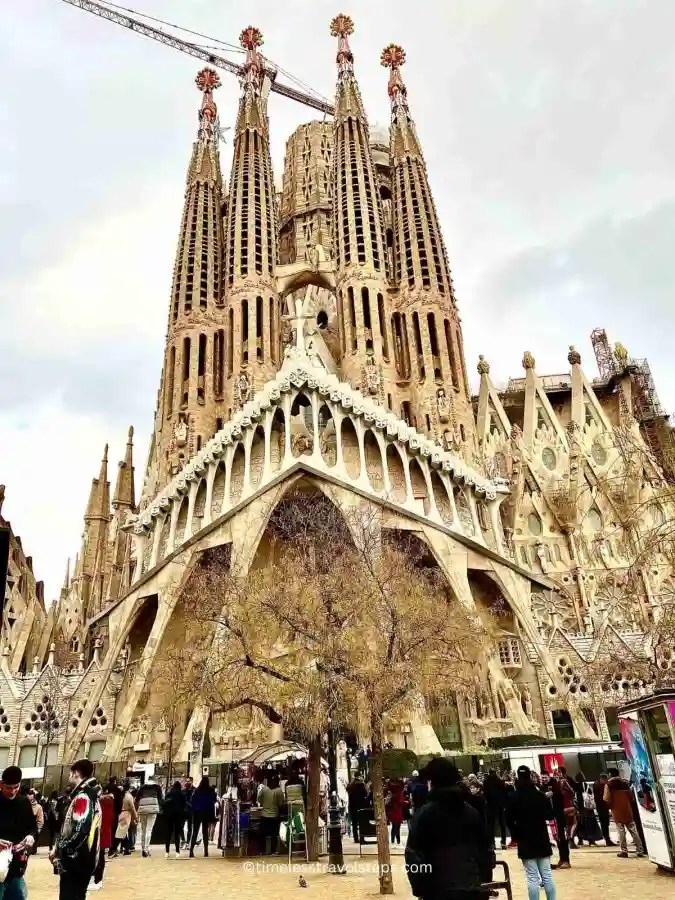
Visit the Celebrated La Sagrada Familia
An absolute worthy destination during your winter visit to Barcelona is the The Basilica of La Sagrada Família (Basilica of the Holy Family). This is one of the most iconic and celebrated symbols of Gothic and Art Nouveau architecture in the world.
Designed by renowned Spanish architect Antoni Gaudí, the basilica has been under evolution since 1883 when the first foundation stone was laid, and work continues till today. The Sagrada Familia is the largest unfinished Catholic church in the world.
A UNESCO World Heritage Site, the Sagrada Familia has become a symbol of Barcelona and Catalonia. A sight to behold, the Sagrada Familia is one landmark in Barcelona which you absolutely cannot miss.
Huge and impressive from the outside while a jaw-droppping sight once you step in. A place where you will go “wow” at every turn! The Sagrada Familia is a place that you have to experience first hand as no pictures can do it justice. I was completely awed by the sheer size, the elegance and the rainbow-coloured glass windows. This celebrated cathedral is so different to the other celebrated cathedral I had seen in Spain.
I highly recommend that you include La Sagrada as one of the best things to do in Barcelona during your winter visit. Truly, you can’t come to Barcelona and not visit La Sagrada Familia.
The Sagrada Familia is the busiest tourist destination in Barcelona and is ALWAYS busy no matter the season or time of day. If you decide to visit this iconic landmark, you must pre-book your timed ticket/s online in advance of your visit.
Take a look at this short IG reel about the outside and inside of La Sagrada Familia.
What to look out for when you visit La Sagrada Familia:
You can appreciate the breathtaking architecture, learn about its fascinating history, and explore the intricacies of Gaudí’s unique vision. The impressive Sagrada Familia is packed with religious symbolism.
Inside the La Sagrada Familia, you can access two of the nine towers but you need a ticket that includes this option. You can select the Nativity Tower or the Passion Tower to suit your interest as both towers give you fascinating views over Barcelona. One thing to note, however, is that you can take the escalator up but must take the stairs on your way down.
On the outside of La Sagrada Familia, make time to observe the three distinct facades; The Nativitiy, which features intricate carvings of figures from biblical stories as well as symbols from Catalan culture; The Passion focuses on themes related to the Passion of Christ, full of symbolism and captivating details; and The Glory depicts Jesus’ crucifixion and resurrection along with his present and future glory.
Gaudi was passionate about nature and its many forms. He showcases his passion by designing the pillars as slender tree trunks, thus creating a concrete forest in the basilica’s interior.
Gaudi left several detailed sketches for his successors to complete the work correctly.
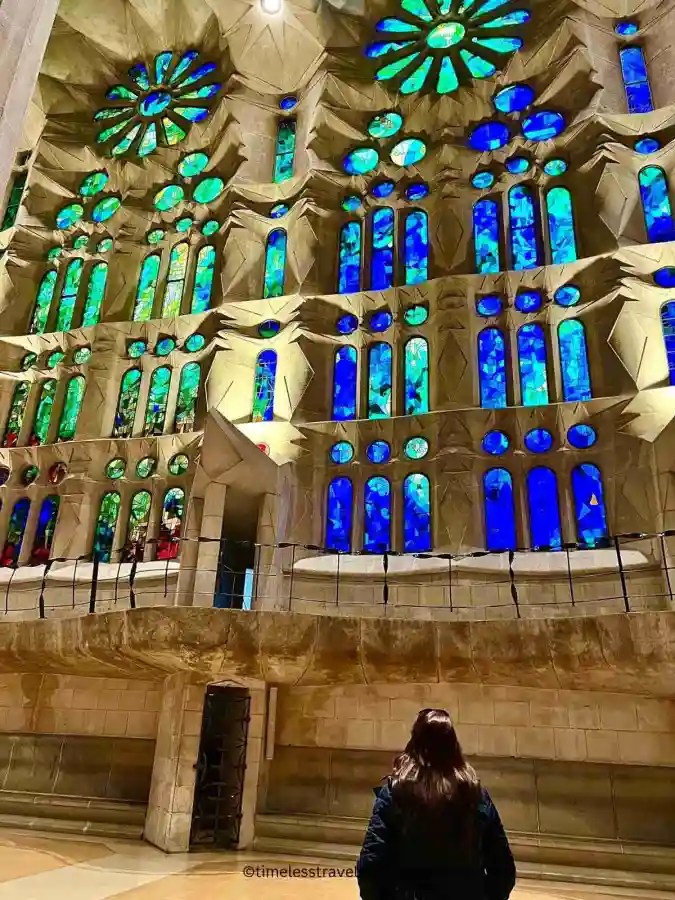
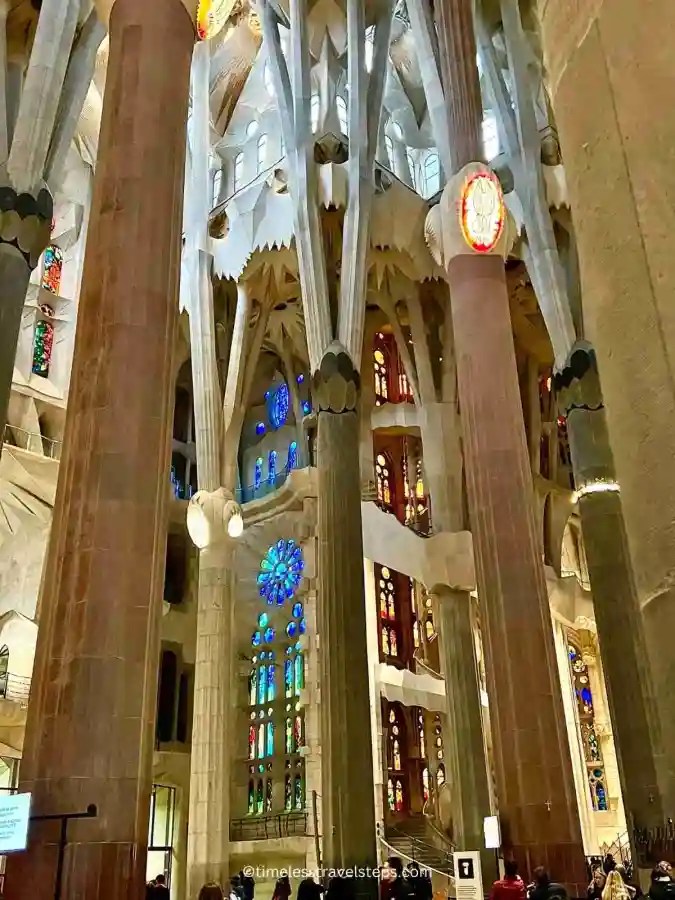
Attending a Mass at La Sagrada Familia
Masses at La Sagrada Familia are held at two Altars: the Main Altar and at the Crypt Altar on Sundays every week. The entrance for the Main Altar is at Carrer de la Marina and you can access the Crypt Altar via 318 Sardenya Street.
Good to know before you go:
Time: I’d suggest two hours as a minimum. However, if you are visiting the towers, give yourself at least two to three hours.
Best time to visit: If you want to avoid the crowds, visit first thing in the morning when the church opens at 9:00 AM. We visited just after lunch time, around two and spent about three hours. It was still a very busy atmosphere. The timing was perfect as the sunlight struck the windows, the colourful illumination was captivating.
Suggestions and Tips for visiting the Sagrada Familia
Pre-book skip-the-line tickets online in advance and avoid wasting time waiting in queues or being disappointed at last minute due to a sell-out occassion.
You need to allow extra time for locating the entrance (there are several) and to go through the security checks.
Tip: In high season, plan ahead and give yourself extra time as you still need to queue even with skip-the-line tickets.
PRO TIP: Join a guided tour. There is so much symbolism, interesting facts and stories about the Sagrada spanning the 140 years that you will totally miss without a guide. Having a guide enhances your visit instead of getting the tickets and going on your own.
*If you decide to join a guided tour, opt for a guided tour that includes tower access. The view over Barcelona from the tower is spectacular.
*Guided tours of La Sagrada usually lasts 1.5 hours but you can stay on for as long as you like to explore deeper after the tour.
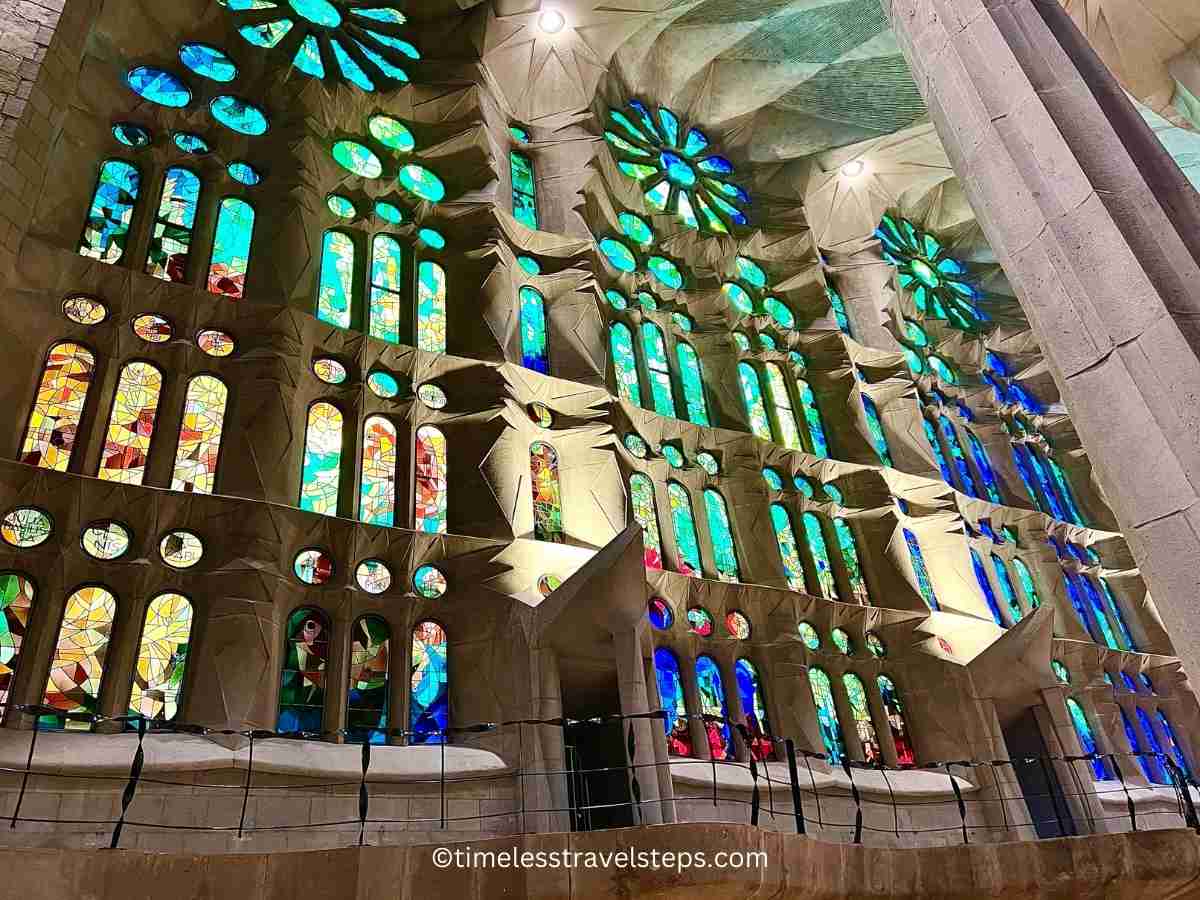
Explore Ciutat Vella (Barcelona Old City)
Nestled between the Mediterranean Sea and the famous l’Eixample district, Ciutat Vella is the oldest district in the city of Barcelona.
Ciutat Vella or Barcelona’s Old City consists of four neighbourhoods: El Raval, Barri Gotic (Gothic Quarter), El Born, and La Barceloneta. Each neighbourhood is distinct and has its unique atmosphere.
Although we visited Barcelona in winter, the Old City was exuberant with activities and offered plenty of opportunities to explore.
Gothic Quarter Barcelona
The most beautiful and definitely not to miss is Barri Gotic (in Catalan) or the Gothic Quarter (in English). The Gothic Quarter is a compact area and sits southeast of Placa de Catalunya, between La Rambla and Via Laietana and between Barcelona harbour and Ronda de Sant Pere.
The picturesque Gothic Quarter is the heart of Barcelona. Dominated by many medieval narrow and winding alleys, swathed in fascinating history, and presents a delightful part of Barcelona.
This area is home to stunning stone architecture such as the famed El Pont Del Bisbe (Bishop’s Bridge), many of the city’s churches including the Cathedral of Barcelona and vibrant squares including one of the most famous Placa Reial (Royal Square).
The Gothic Quarter has an energetic scene with lots of bars, restaurants, theatres for flamenco shows, museums and speciality shops.
Raval Barcelona
El Raval is a charming shopping zone and is home to the famous public market, El Boqueria.
El Born
Situated to the east of the Gothic Quarter, El Born is separated by Via Leietana and is famous for its lively scene, famous bars, restaurants and clubs. It is one of the most bohemian parts of Barcelona. El Born is also home to a variety of galleries (MOCO Museum is located here: more on this below), boutiques and the 14th century Church of Santa Maria del Mar.
Barceloneta
Situated between the old harbour and the beach, the Barceloneta neighbourhood is the smallest neighbourhood in Barcelona by population. This area is not within the historic centre of Barcelona.
Suggestions and Tips for Experiencing Barcelona Old Town
PRO TIP: There are several guided tours that visit this area of Barcelona. These tours are a great choice as it combines a visit to other important sights in the city.
You can choose from a full day city walking tours which is great value for money, or fun e-bike tours. You may want to join a food tour which is a great way of learning the history, culture and cuisine of Barcelona. Any one of the three tours are a great and fun way to get to know the city of Barcelona better.
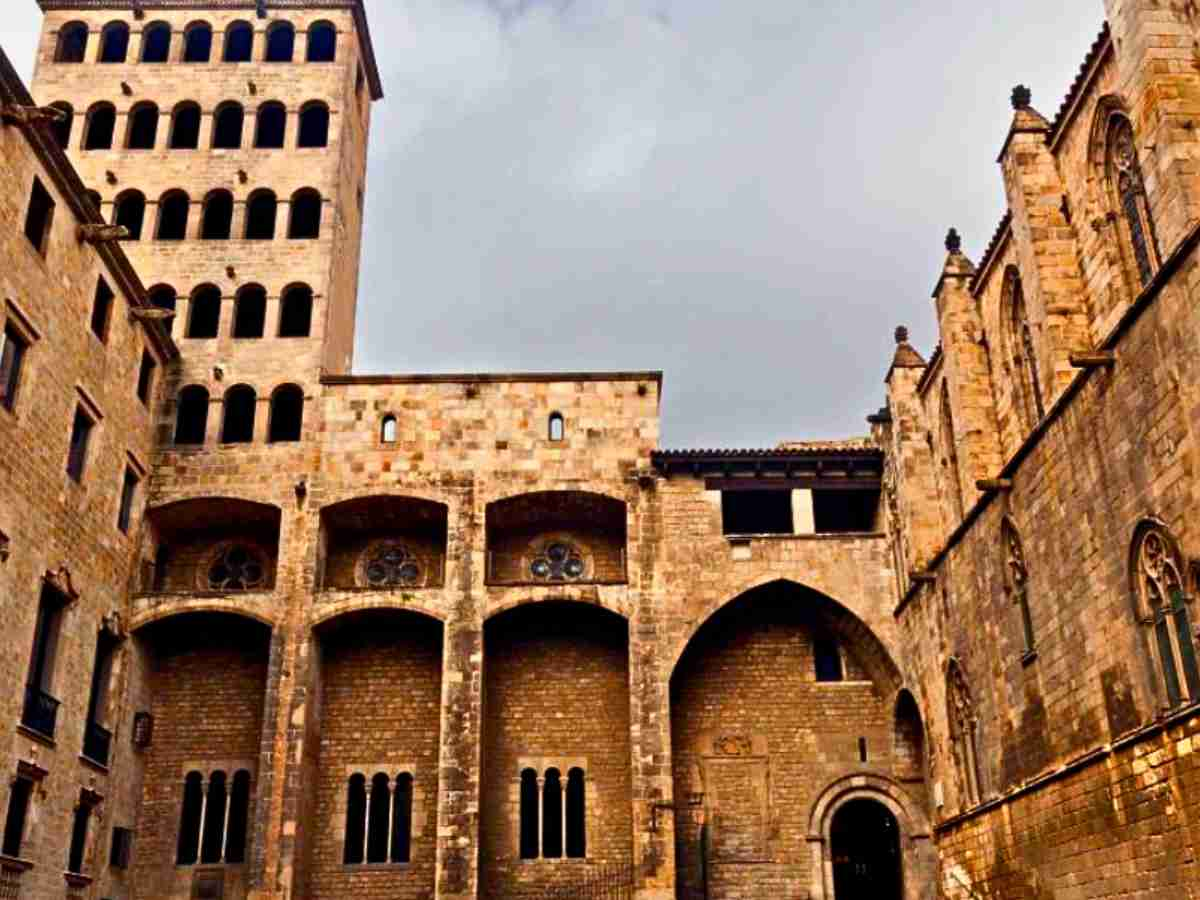
MOCO Museum, Barcelona
The MOCO Museum in Barcelona is a must-visit for art lovers! This was one of our favourite evening activities during our Barcelona in winter escape.
Located in the Old Barcelona, MOCO Museum is an independent museum, showcasing a wide range of modern, contemporary and street art from around the world.
Housed in a 16th century palace, the museum features a wide range of pieces from iconic figures such as Salvador Dali, Frida Kahlo, Banksy, Takashi Murakami, Damien Hirst, Jeff Koons, Tracey Emin, Yayoi Kusama, David LaChapelle, Guillermo Lorca, Nick Thomm, KAWS, Andy Warhol, and more.
Suggestions and Tips for MOCO Museum:
PRO TIP: Book online and save €2 – €5 per ticket
Check the official website >> MOCO Museum, Barcelona
Hours: 10:00 — 20:00 | Closes at 21:00 on Friday, Saturday & Sunday.
Add: Carrer de Montcada, la Ribera 25 08003 Ciutat Vella, Barcelona.
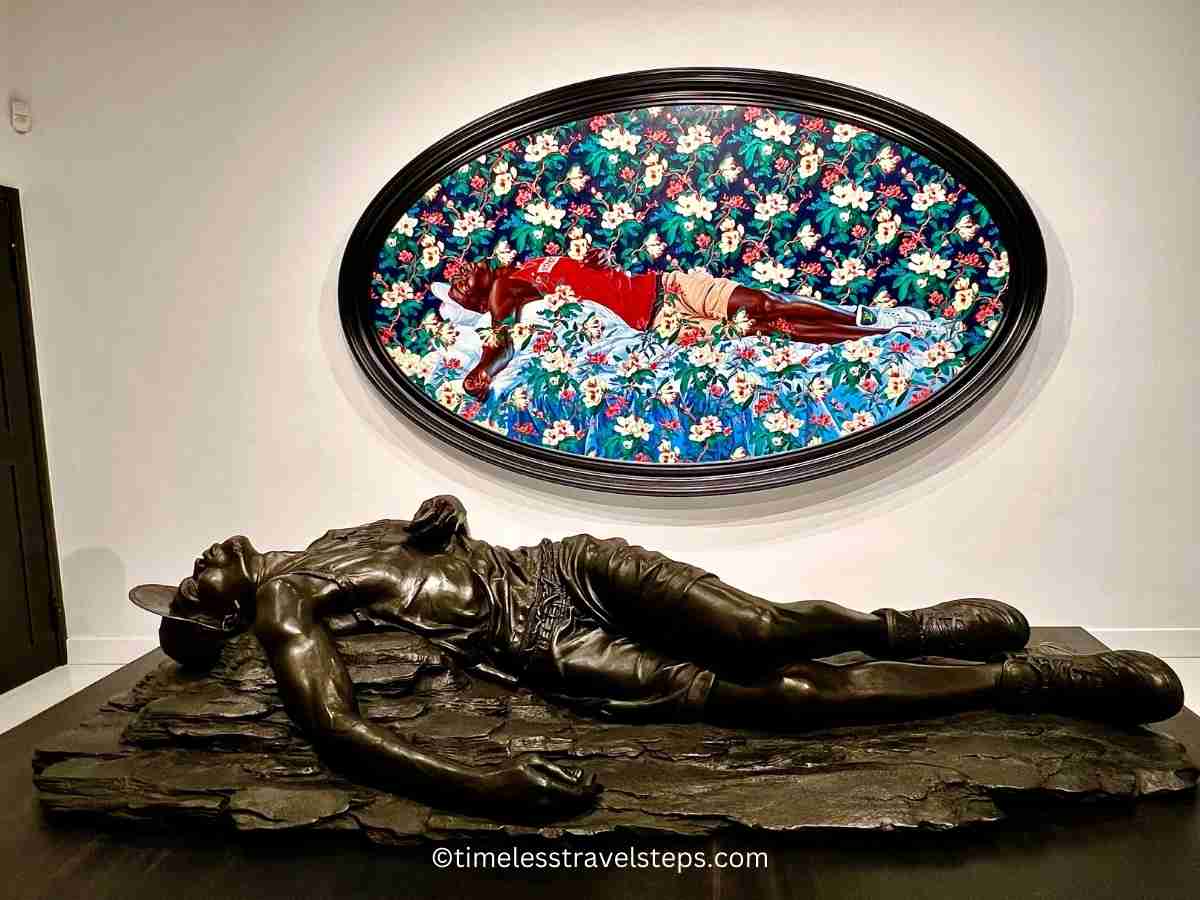
The Cathedral of Barcelona
The iconic Barcelona Cathedral or the Cathedral of the Holy Cross and St Eulalia is the seat of the Archbishop of Barcelona. Built in the 14th century in a Neo-Gothic style, the Barcelona Cathedral 12th century Roman Temple. It is more traditional and totally different to the Sagrada Familia, but worth visiting just as much.
Located in the heart of the Gothic centre, the Barcelona Cathedral is one of the largest and most impressive cathedrals in Catalonia.
Barcelona Cathedral is dedicated to Saint Eulalia, a young thirteen-year old who was tortured to death during the Roman reign. Her tomb lay buried beneath the main altar of the cathedral.
What to look out for:
The architecture of Barcelona Cathedral is truly outstanding. Its interior is spectacular and one not to miss. The exterior is adorned with gargoyles, intricate details of mythical statues and pinnacles.
Take a walk in the picturesque garden of palm trees and magnolias. You will come across a large raised pond: the Well of the Geese (Fuente de las Ocas). This pond is home to thirteen white geese. Some say the geese are there to protect the cathedral as the Romans once did, while others say it represents the age of Saint Eulalia when she died.
Good to know before you go:
You will need a ticket to visit the Cathedral of Barcelona. If you prefer, you can pre-purchase online and save time queuing up at the ticket office.
You could take the elevator to the cathedral’s roof for a good view of the city’s skyline.
Also, ensure that you wear appropriate clothing: knees and shoulders covered; shorts and sleeveless clothes are not allowed as these are considered disrespectful.
Tourists visiting hours: Generally from 09:30 to 16:30 with last entry at 17:45
Add: Pla de la Seu s/n 08002 Barcelona
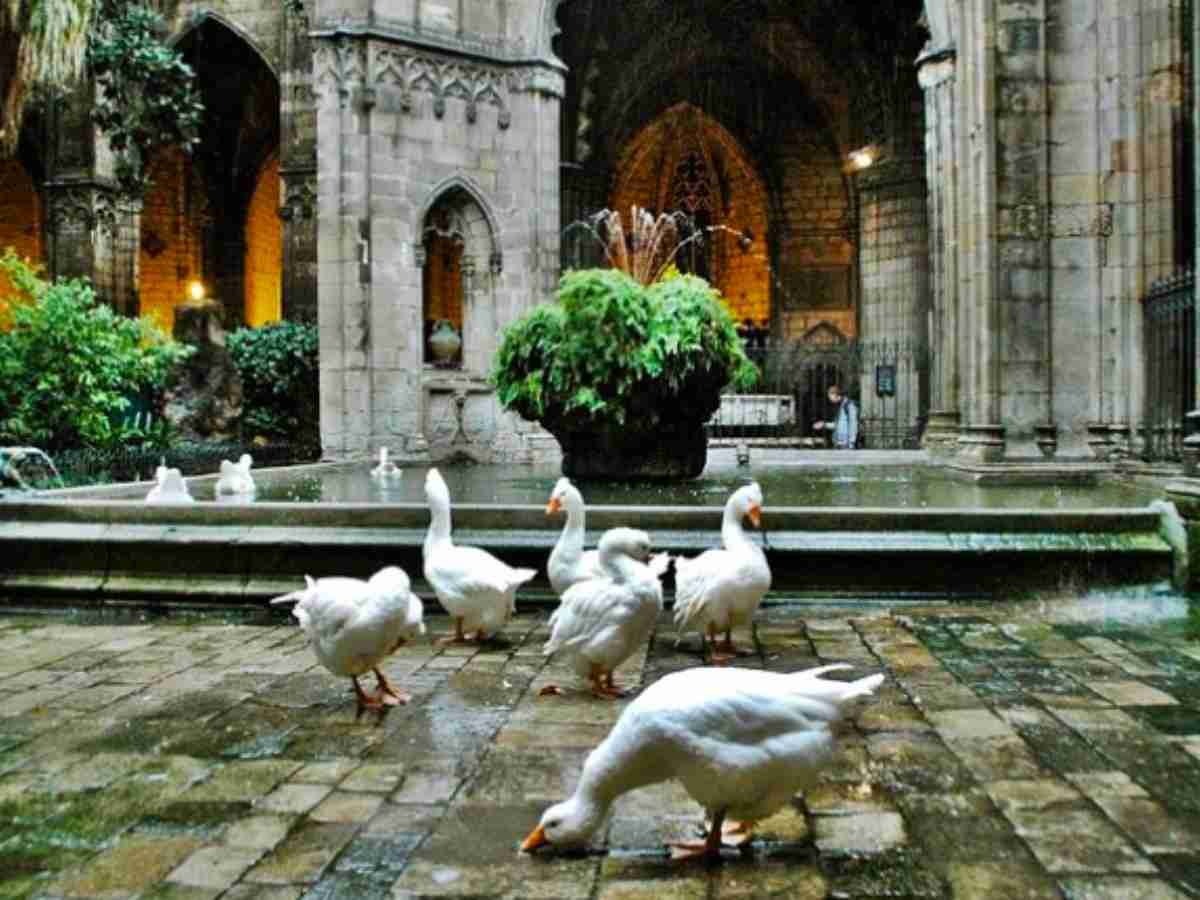
Visiting La Rambla, Barcelona in the Winter
La Rambla also famously known as Las Ramblas, is Barcelona’s most famous street and a landmark.
You won’t miss this large tree-lined pedestrian avenue that runs through the heart of Barcelona, as most tourists come here. It stretches 1.2 km. and connects La Rambla to the Placa de Catalunya in the centre of the city to Christopher Columbus Monument at Port Vell.
If you walk from Placa de Catalunya towards Port Vell, the Gothic Quarter is on your left and El Raval on your right. The entire stretch crosses Barcelona Old Town with many of the sights nearby.
This area is full of life and packed with souvenir shops, eateries and buskers even in winter. It is busy and crowded. No trip to Barcelona is complete without walking through La Rambla.
Earlier mornings are best to avoid the crowds if you want to explore the area as well as to enjoy the beautiful architecture.
What to look out for:
Font de Canaletes: A small drinking fountain where Barcelona football fans come to celebrate their victory.
Palau Güell: An impressive mansion designed by Gaudi and built between 1886 and 1888. Located in the Carrer Nou de la Rambla, within the El Raval neighbourhood. Palau Güell is a UNESCO World Heritage Site “Works of Antoni Gaudi”
Placa Reial in the Gothic Quarter: A beautiful square with palm trees, mentioned above.
Boqueria Market: Founded in 1836, the Boqueria Market is the most famous market in Barcelona. There are more than 200 traders offering both local and international choices in fresh fruits, fresh seafood, meats and cheeses.
Good to know before you go:
The restaurants and cafes along La Rambla are noted as being of low quality. I did not try any of the eateries here, so I cannot say otherwise. Your best dining option is to head to Boqueria Market nearby or the restaurants in the Gothic Quarter. Also, this is one place where you need to keep your personal belongings, especially your mobile phone really close.
Suggestions and Tips for best experience of La Rambla area
PRO TIP: For a complete experience of Barcelona’s authentic cuisine, join a food and drinks tour. This particular food and drinks tour takes you to the most historical neighbourhoods of Barcelona. You visit five of the best bars and restaurants in the area most frequented by locals, and enjoy local cuisine and drinks. This tour combines a visit to La Boqueria market.
Also, during your Barcelona winter vacation, this walking tour is best for you if you want to experience the vibrancy of La Boqueria market along with Catalan food traditions. In this tour, you will see a few landmarks as well while learning about the patterned walkways on the way.
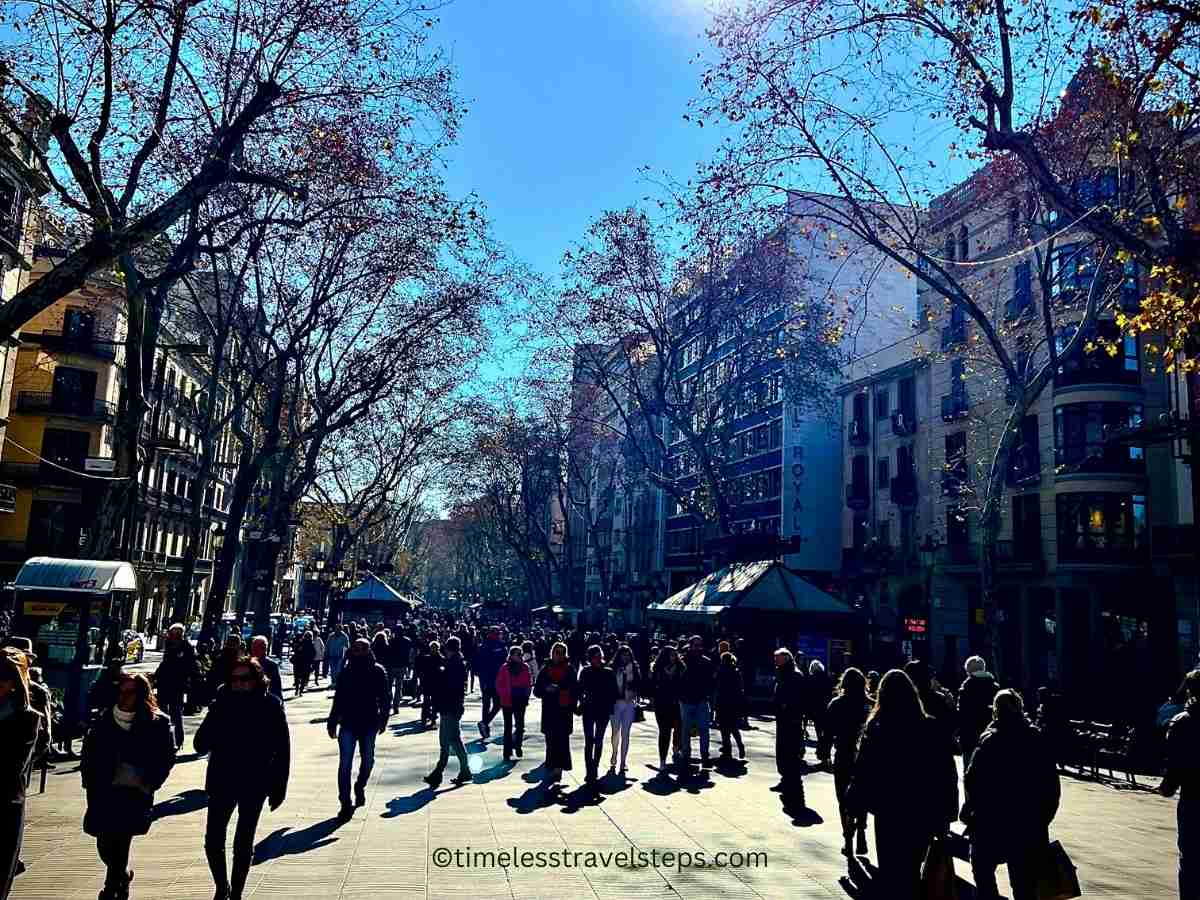
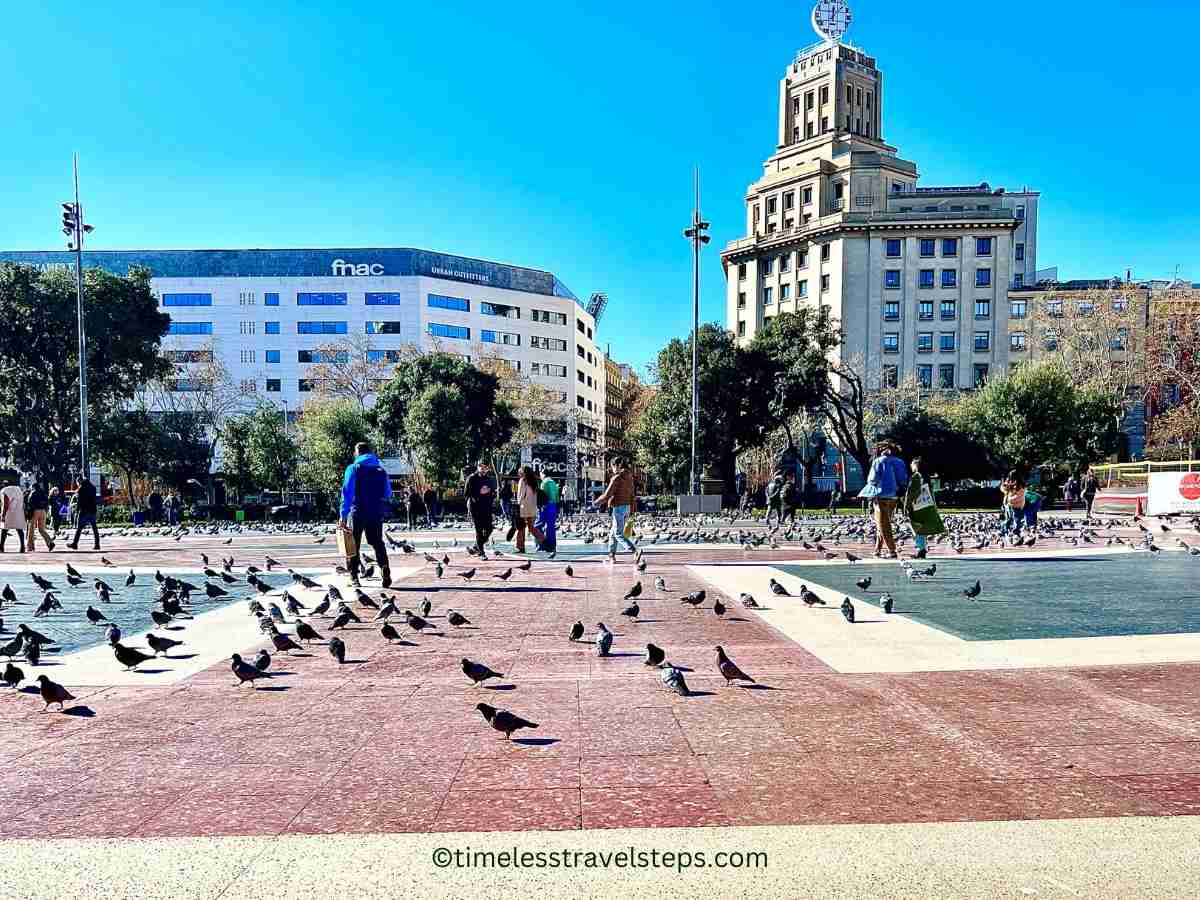
Park Güell, Barcelona in the Winter
Another of Gaudi’s brilliant creations, Park Güell is a magical garden that was never intended to be a park. Initially commissioned by the Spanish Count Eusebi Güell who envisioned a model city for Barcelona’s elite.
The Count died in 1914 and Gaudi continued on with the project to turn it into an enchanting space. Subsequently, the park was purchased by the City of Barcelona and was turned into a ticketed park.
Park Güell spreads over 17 hectares of hilly grounds and consists of lush gardens, and unique architectural elements, a great escape in Barcelona in the winter months.
Gaudi brought a fairy-tale to life with his unique architectural approach. He invented Trencadis, a mosaic created with small pieces of broken ceramics. He used this technique in an effortless fluidity throughout the park where concrete architecture stands alongside nature.
From sculptures such as the salamander, the snake or octopus to flower motifs sprinkled throughout the park. The enchanting Park Güell is one of the best things to do in Barcelona during winter.
What to look out for:
The grounds are massive with a maze of paths and stairs. There are many stone benches to sit with viewing points for brilliant views over Barcelona. In particular, ensure you visit the following highlights at the very least:
Dragon stairway: This multicoloured mosaic salamander with a fountain is the most popular attraction in the park and stands guard over two-flight of stairs.
The Hypostyle Room or Doric Temple: This is a 86 stone column structure constructed to give a natural look. Located beneath the serpentine bench, accessed by stairs.
Serpentine bench: This long and undulating bench created with colourful mosaics is a must-visit! The views across the city are absolutely breathtaking. This place is really busy and we visited in winter. If you wait a few minutes, you can have a space to sit for a while.
Gaudi House Museum: This is one of the original houses in the park where Gaudi himself lived at one point. It is now a museum exhibiting some of his life’s work.
Good to know before you go:
Tickets
TIP: Park Güell is one of the most popular attractions in Barcelona and long queues are inevitable. If you are travelling during the high season, you must book at least a couple of weeks earlier if you really want to visit this enchanting park. Be sure to book your tickets online in advance of your visit. Tickets are timed and you are allowed a half-hour window in case you are late.
If you can, visit Park Güell in late afternoon and stay on for the sunset. The skyline at sunset viewed from the Serpentine bench is absolutely gorgeous and the atmosphere is totally mesmerising. I highly recommend that you try visiting at this time for the best experience.
During our Barcelona in winter escape, we visited Park Güell for about 3:30 and stayed on to catch the early rays of sunset when the daylight was softer and pink. It was one of our best experiences of Barcelona in the winter..
Getting to Park Güell
Park Güell is located a little out of the city centre. The nearest metro stations to Park Güell are either Lesseps or Vallcarca. Both stations are on the L3 metro line. Both stations involve a 20-minute walk to the main gates of Park Güell.
We took a taxi to and back from Park Güell. There is a taxi rank near the park.
Hours: From 09:30 to 19:30 daily.
Add: Park Güell, 08024 Barcelona, Spain.
What to wear:
Wear comfortable clothes and footwear. Park Güell is located on hilly grounds. There are lots of steps and stairs to climb uphill and downhill. Most of the paths are made from dirt. Trainers are ideal.
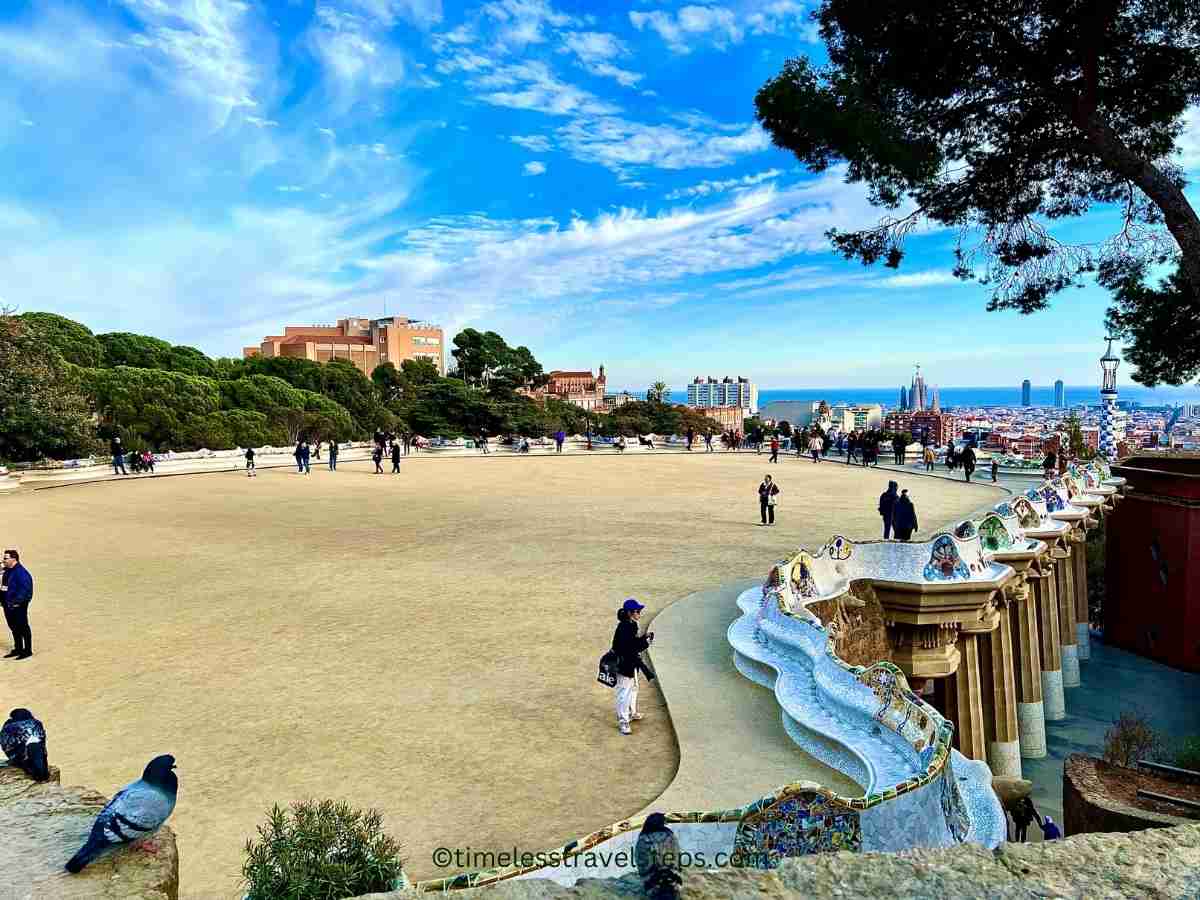
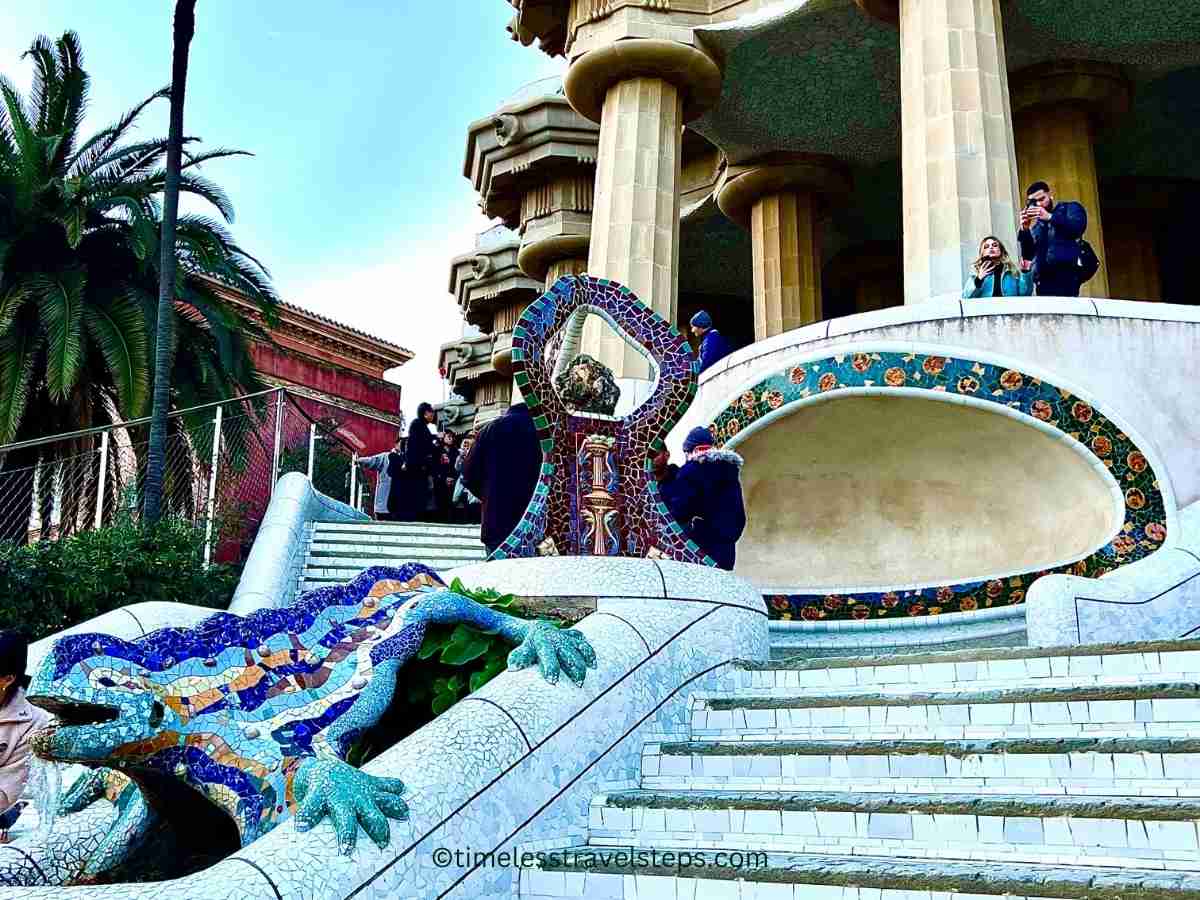
Visiting Casa Batlló, Barcelona in the Winter
The iconic Casa Batlló in the centre of Barcelona’s famous street, Paseo de Gracia is a must-see for those who want to discover Gaudi’s work. This exemplary architecture by Gaudi is one of the most popular attractions in Barcelona and attracts over a million visitors a year.
Originally constructed in 1877. Casa Batlló was redesigned and remodelled by Antoni Gaudi in 1904 at the request of the prominent businessman and owner, Josep Batlló i Casanovas. Gaudi worked his magic and created a distinctive masterpiece that we see today.
Casa Batlló, is known by several names such as the “house of masks”; “house of bones” but more popularly as the “House of the Dragon.” A UNESCO Heritage Site, Casa Batlló is a gateway to a world of imagination that inspires everyone who walks through its doors.
What to look out for at Casa Batlló:
When visiting Barcelona in the winter, you’ll be captivated with the intriguing exterior to the magical, opulent interior and all the way to the dragon rooftop, Casa Batlló is truly extraordinary. Gaudi drew inspiration for his creative designs from marine shapes, creating a dream world that represents waves on a calm day. You really got to see this!
Gaudi, a free and cheerful artist created one of the most interesting facades with great imagination. Mysterious. The facade features balconies, with wobble cast iron railings sitting on a stone base in what appears to be shaped in a shell.
Beyond the facade, Casa Batlló gives an alluring marine feel. The entrance hall has an underwater feel with the central patio decorated in blue tones. Popularly known as the House of the Dragon, Casa Batlló is said to be associated with the Legend of Saint George, the patron saint of Catalonia.
When you get to the spectacular roof, you’ll be awestruck by its large colourful ceramic tiles, to resemble a dragon’s back. This incredible attraction is one of the best things to do in Barcelona in the winter.
Good to know before you go:
Casa Batlló is a popular attraction, so be sure to book your tickets in advance. The best time to visit is first thing in the morning. Late afternoons are also a good time to visit as it is less crowded.
Suggestions and Tips for Experiencing Casa Batlló
TIP: If you want to experience Casa Batlló when it is less crowded, join this limited availability guided tour in the morning. This tour is designed that you may have entry first thing in the morning before the crowd gets in.
Hours: 09:00 — 20:30 (Mon — Fri); Sat & Sun till 22:00
Add: Pg. de Gràcia, 43, 08007 Barcelona, Spain
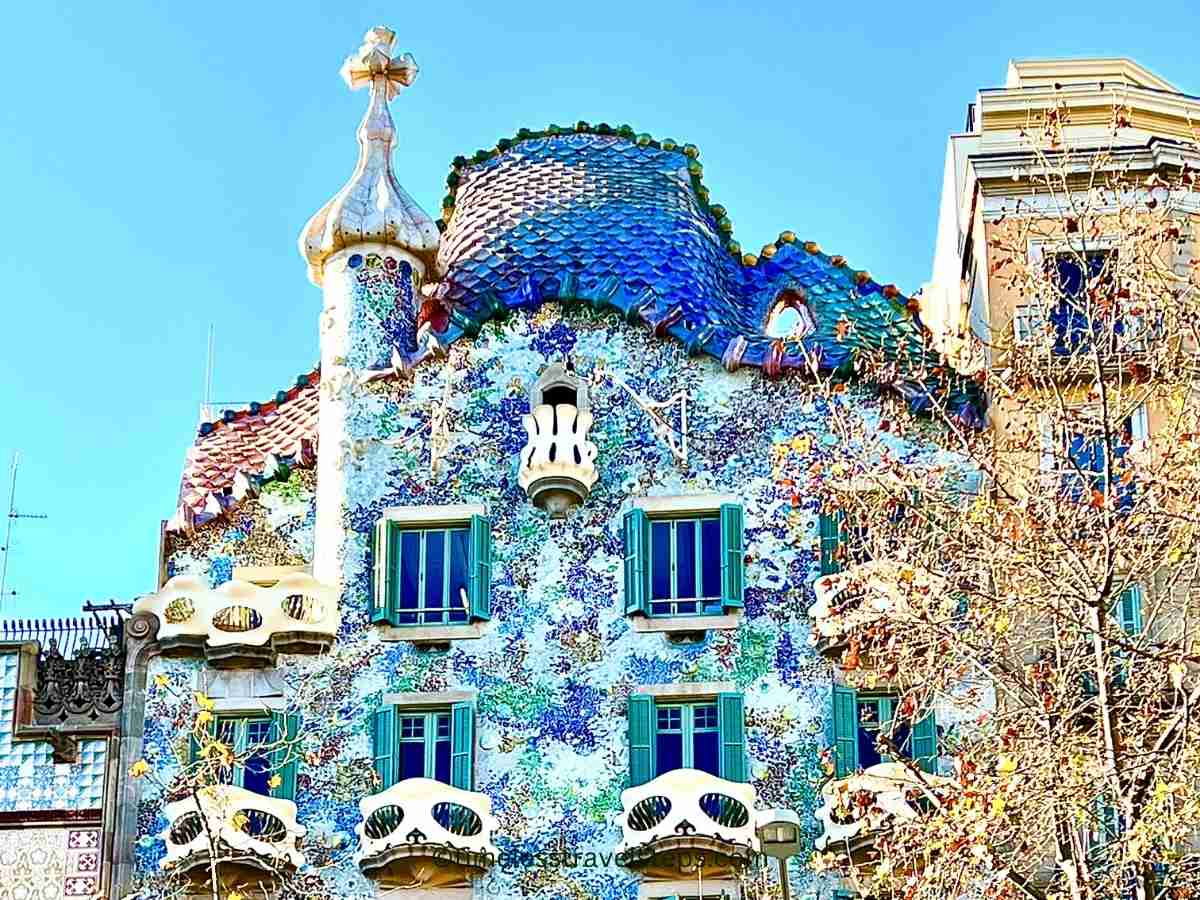
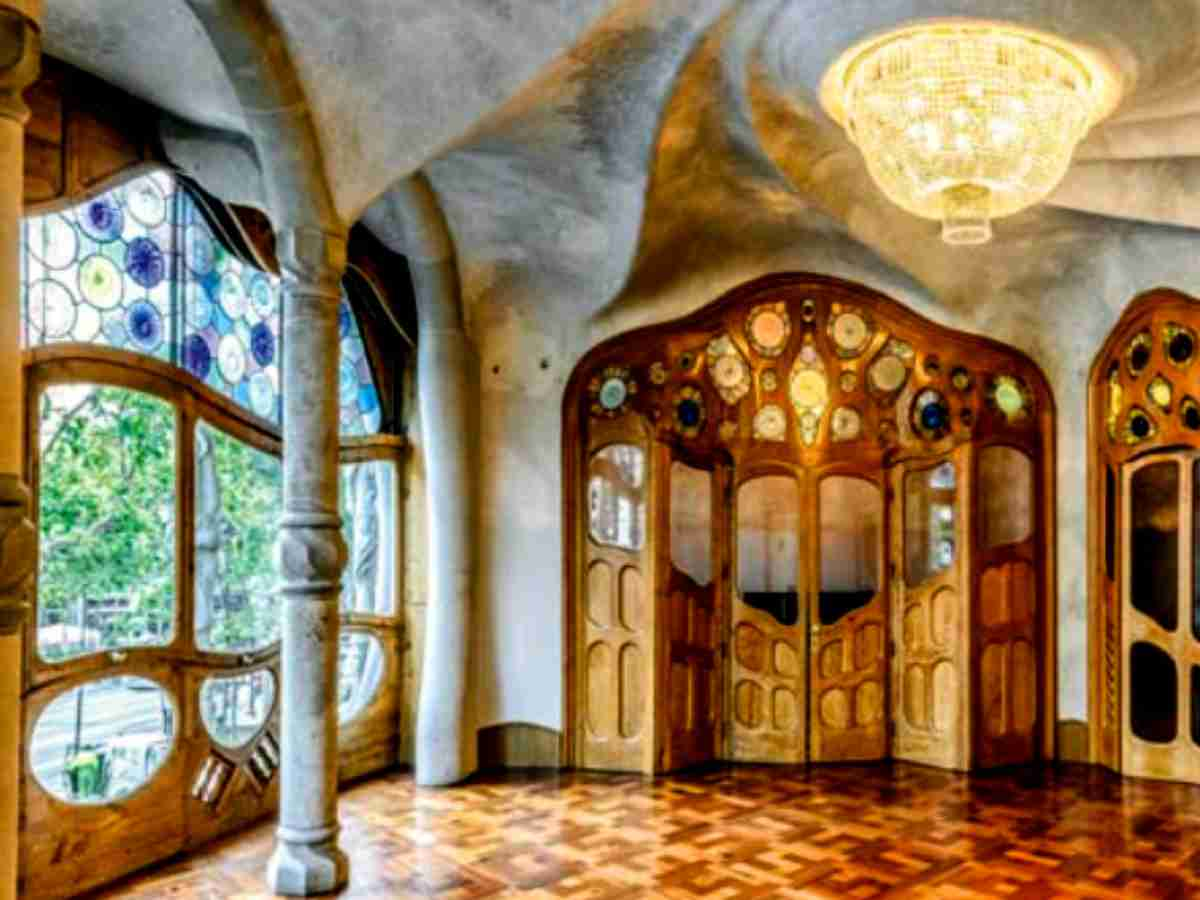
Casa Mila, Barcelona
Casa Mila, simply known as La Pedrera (the stone quarry) is another famous building designed by Gaudi. A private residence built between 1906 and 1912, it was the last building that was designed by Gaudi.
Like Casa Batlló, La Pedrera is a UNESCO Heritage Site and is a popular attraction to visit in Barcelona.
What to look out for at Casa Mila
La Pedrera is a rare creation. Gaudi broke with the architectural style of his time to construct a building of a curtain wall made from blocks of stone. More than 6000 stone blocks were used, connected with metal rods to create large windows. He also gave it an unusual rough-hewn appearance, making it look natural rather than artificial.
The wall paintings and tapestries in the entrance hall depict mythological themes of the god of seasons and the goddess of fruit trees. The tenants apartment on the fourth floor showcases the decorative figures that Gaudi designed such as the door knobs, mouldings, doors and floor surfaces.
Good to know before you go to Casa Mila:
Like most of Gaudi’s sites, Casa Mila is a highly favoured attraction. If you want to experience this particular Gaudi’s masterpiece, and see the interior, you should really book your skip-the-line tickets in advance.
Suggestions and Tips for Casa Mila:
TIP: For timeless memory, consider visiting in the evening, after dark. The rooftop is lit up and you can experience a dazzling light show. To learn more about this special experience, go here for the La Pedrera nighttime experience.
Time: One hour.
Hours: From 09:00 to 22:00 daily
Add: Pg. de Gràcia, 92, 08008 Barcelona, Spain
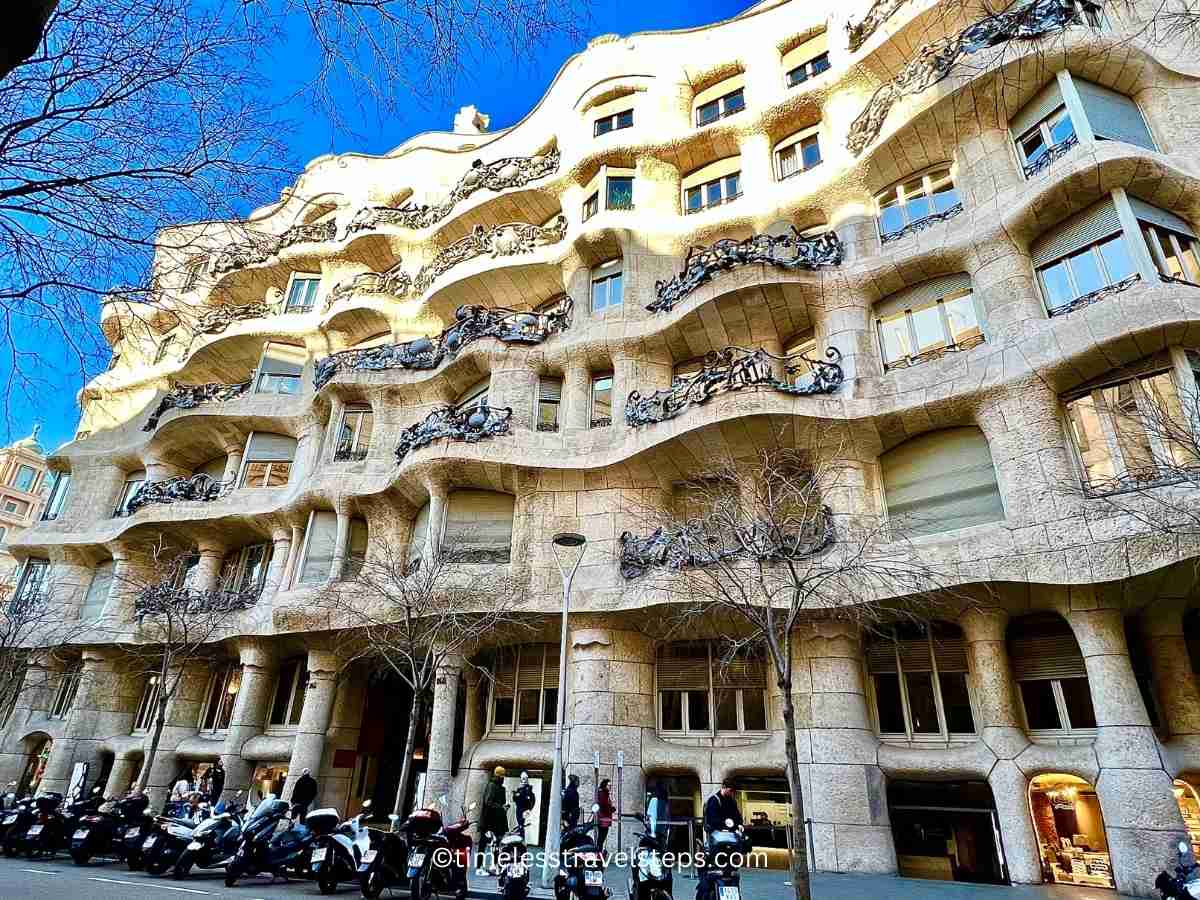
Visiting Paseo de Gracia Barcelona in Winter
One of Barcelona’s most important street, Passeig de Gràcia is a place you have to experience. It is in the central part of Eixample, stretching from Plaça Catalunya to Carrer Gran de Gràcia. Along this historic and famous street are some of the city’s most remarkable architecture, high-end brands, top hotels, bars, cafes and restaurants. The above mentioned Casa Batlló and Casa Mila are located on this avenue.
What to Look out for
Look out for some of the famous mansions by other renowned Spanish architects: Casa Amatller by Josep Puig (located next to Casa Batlló); and Casa Lleó Morera, designed by Lluís Domènech i Montaner in 1902. Casa Amatller, Casa Batlló and Casa Lleó-Morera, makes up the three most important buildings in Barcelona’s famous Illa de la Discòrdia (“Block of Discord”). They are noted for its unique, contrasting modern buildings.
As you walk along this busy avenue in Barcelona during your winter escapade, take note of the hexagonal tiles on the pavement. These tiles follow the same pattern of natural elements such as starfish. It was originally designed by Gaudi and was meant for the floors in Casa Batlló. The designs were later reproduced for the pavement along Passeig de Gràcia.
Suggestions and Tips:
TIP: Many people visiting Barcelona in the winter take a break from sightseeing and go shopping in Passeig de Gràcia. There are a great many luxury international brands to choose from, including Prada, Chanel, Dior, Rolex, Gucci and Louis Vuitton. If you want to take moments to relax during your Barcelona in winter vacation, head to one of the many restaurants and cafes where you can stop for lunch or dinner.
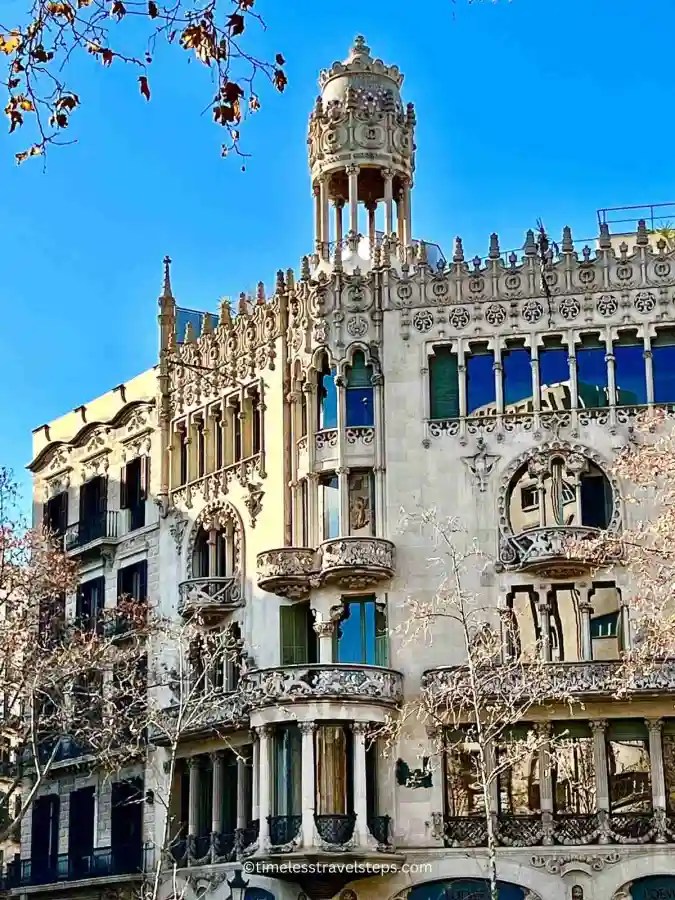
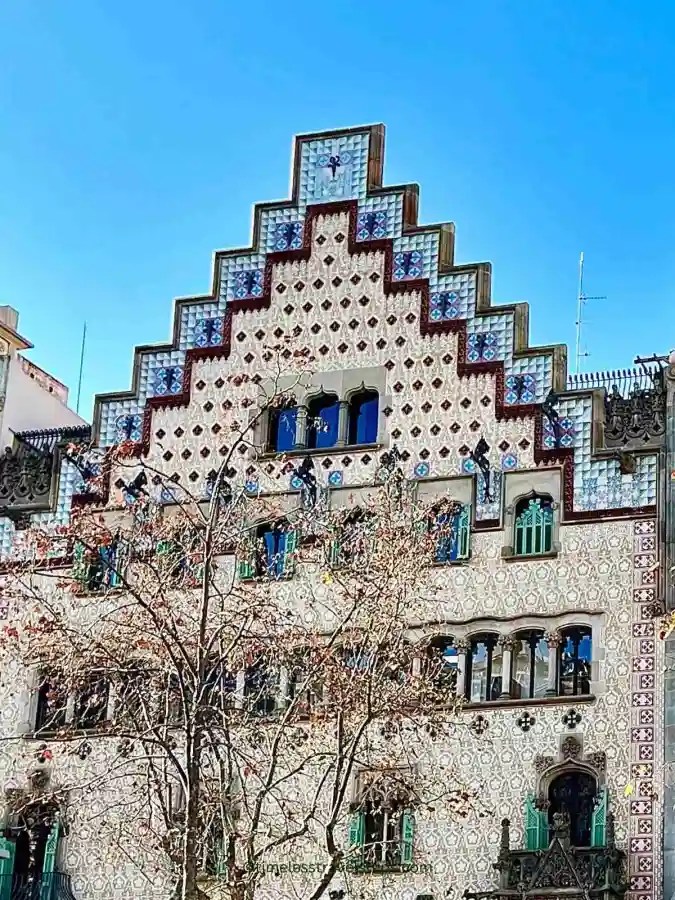
Arc de Triomf and Ciutadella Park, Barcelona
Arc de Triomf, one of Barcelona’s iconic landmarks was built in 1888 as the portal to Barcelona World Fair that was held in Ciutadella Park. With a classic shape and beautiful decorative elements, this majestic monument sits at the top of Passeig de Lluís Companys. At the top of the Arc de Triomf are the coat of arms of the city of Barcelona. Beneath it are the shields of the 49 provinces in Spain.
From here, you can access the Ciutadella Park, one of Barcelona’s most idyllic and serene places. This particularly beautiful park is perfect for a picnic or peaceful stroll. With a lake for rowing boats, pathways, palm trees, numerous statues and a fountain designed by Gaudi, you can easily spend more than an hour or so here.
The grounds of Ciutadella Park is home to several attractions including geology museums, Parliament of Catalonia and Barcelona zoo.
Suggestions and Tips for when visiting the Arc de Triomf and Ciutadella Park, Barcelona in the Winter
Entry to the park is free of charge. You can rent the boats on the west side of the lake.
TIP: The fountain designed by Gaudi is the most striking feature of the park. Be sure to visit it.
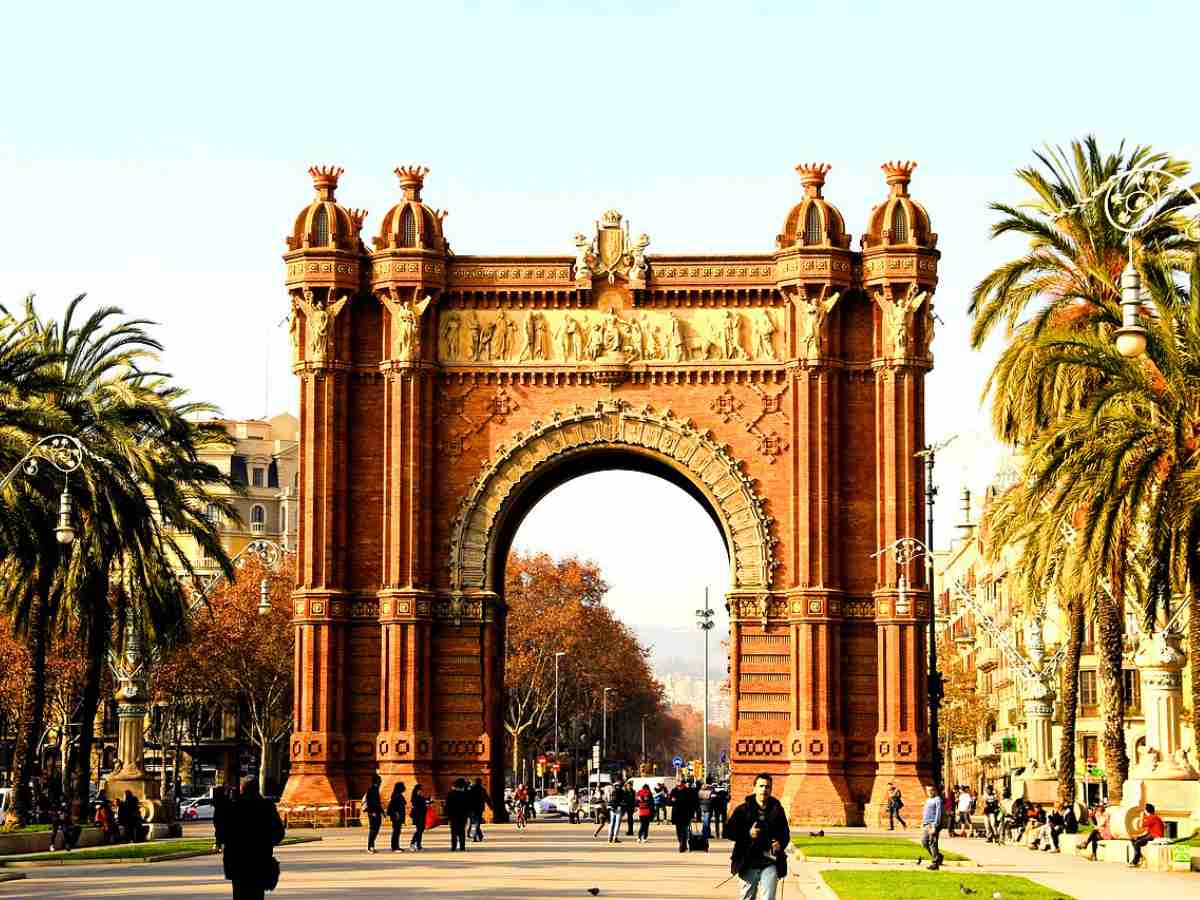
Casa Vicens
A modernist building and unique in style, Casa Vicens is Gaudi’s first project. It was built between 1883 and 1885 and looks nothing like any of his other masterpieces. It looks markedly Asian with its Moorish arches, and art works from India, Persia and Japan. This superb building was recently declared a UNESCO World Heritage Site following a restoration.
Hours: 10:00 — 19:00 daily.
Add: Carrer de les Carolines, 20-26, 08012 Barcelona, Spain.
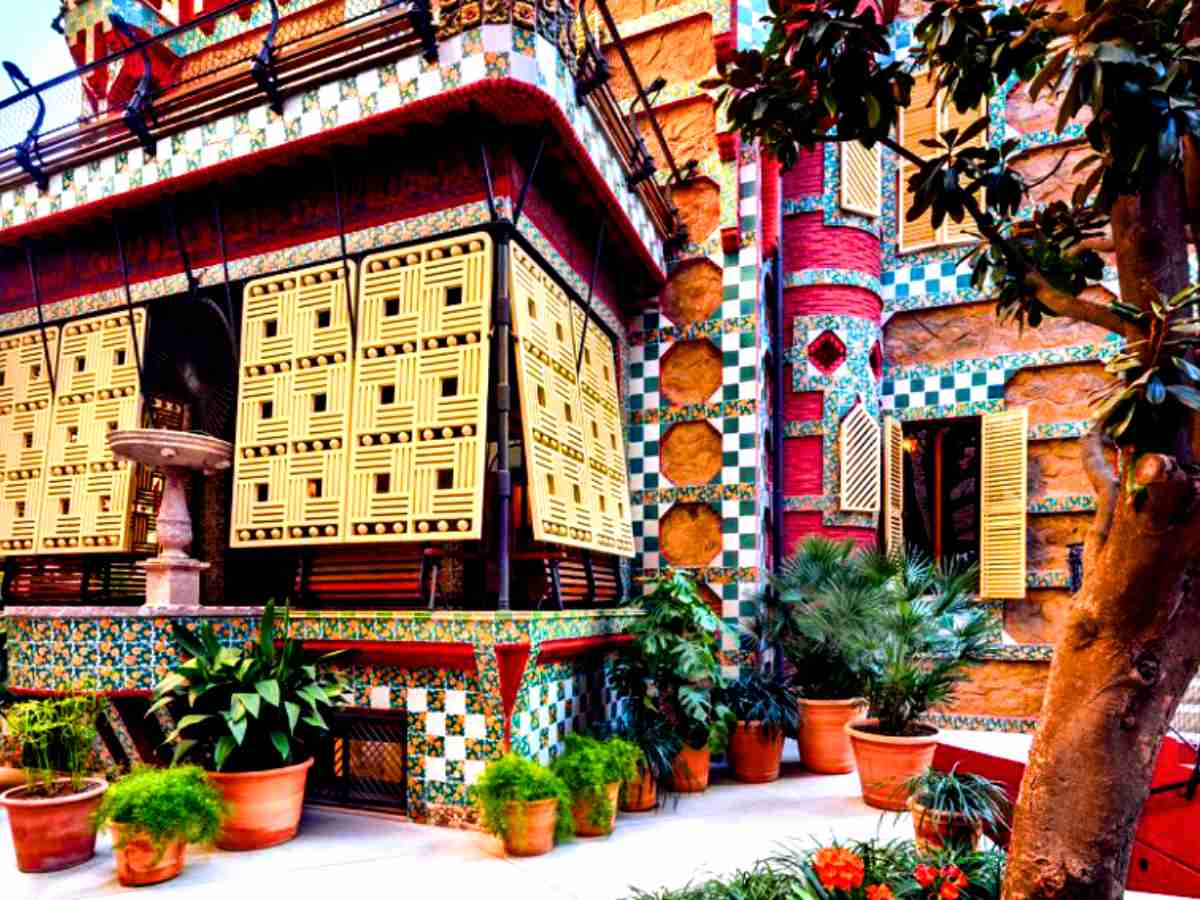
Palau Güell
Palau Güell, another of Gaudi’s landmarks was built in the initial years of his career. This modernist building was commissioned by the renowned businessman of the time, Eusebi Güell who wanted an opulent residence to entertain his high society guests. This striking building is located in the Al Rawal neighbourhood, close to La Rambla shopping area, a great spot to head to in winter in Barcelona.
Palau Güell exudes a luxurious feel, reminiscent of a Venetian palace. From the iron gates at the entrance to the roof terrace graced with mosaics and chimneys. Gaudi installed twenty chimneys on the roof to ventilate the house. You will be amazed at the impressive ironwork, woodwork, ceramics and stained glass along with stone work inside the building.
Good to know before your visit to Palau Güell
While Palau Güell is not well-known as the rest of Gaudi’s landmark creations, it is certainly worth a visit. Staff are knowledgeable and the guided tour is well organised. The chimneys are amazing and are especially worth visiting.
Suggestions and Tips for Palau Güell:
You can visit for free on the first Sunday of every month.
Admission tickets include a free audio guide. You can request a free guided tour when you arrive but you must have pre-purchased your ticket.
Learn more about Palau Güell and book your tickets for an independant visit before you travel. Alternatively, you can join this city walking tour that includes a visit to Palau Güell, which is better and a good value for money option.
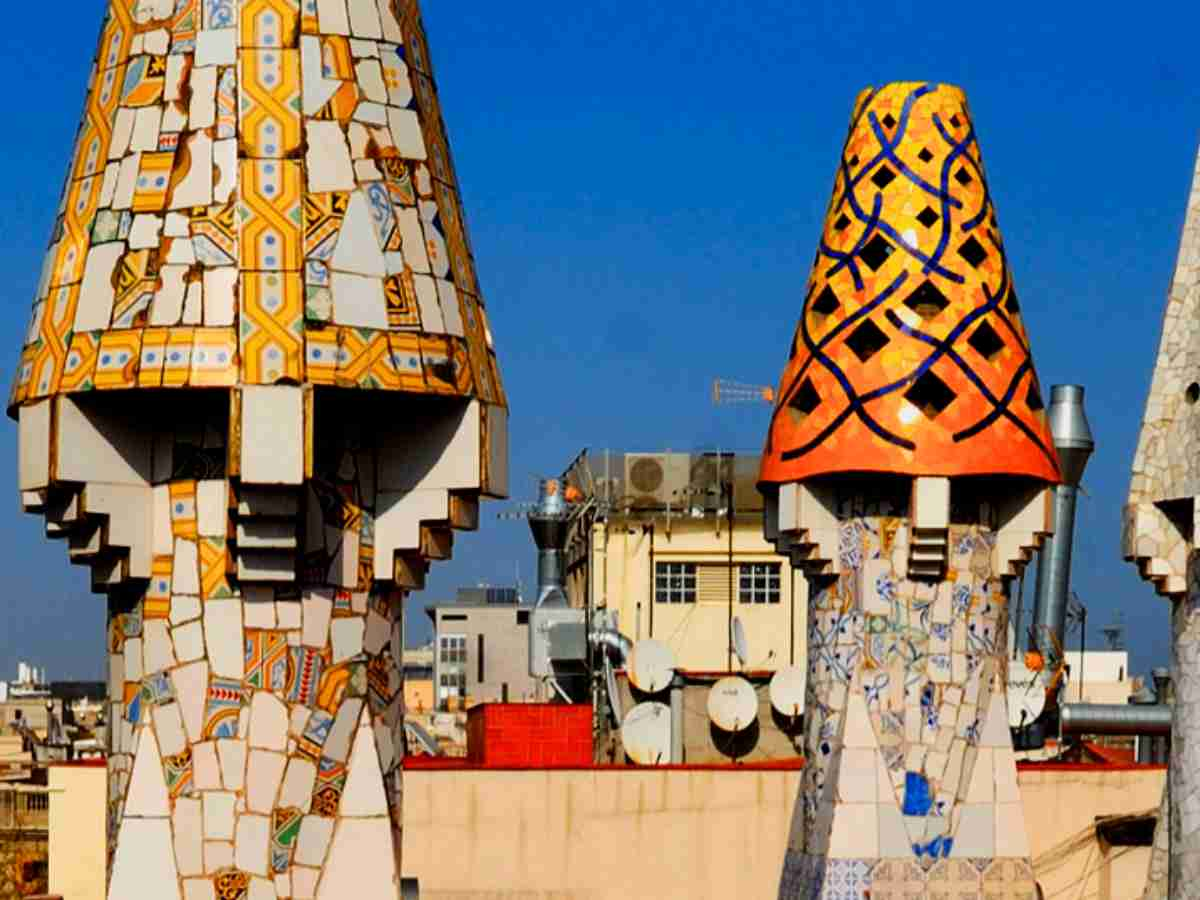
Palau de la Música Catalana
An architectural gem, Palau de la Música Catalana is designed in the Catalan modernista style and is the only building of this style to be listed as a UNESCO Heritage Site. This impressive venue was designed by Lluís Domènech i Montaner and was built between 1905 and 1908.
The exterior of Palau de la Música Catalana is distinct with brightly coloured mosaics. As a working concert hall, this modernist building is symbolic of the cultural heritage and social life of the Catalonians, one of the best sites to visit in Barcelona during your winter escape.
Good to Know before visiting Palau de la Música Catalana, Barcelona in the Winter
As the venue is a working cencert hall, you can also attend the concert here and experience the magnificence of Catalonia’s heritage. The sightseeing tours are available daily, throughout the year. However, tours are not available during concert events. Therefore, if you really want to experience the inside of this majestic building, be sure to confirm your plans in advance.
Suggestions and Tips for visiting the Palau de la Música Catalana:
PRO TIP: The Palau de la Música Catalana sees more than 300,000 visitors annually. It is an especially popular venue for the locals and for this reason ticket slots fill up fast. Be sure to book in advance of your visit if you want to visit here.
You can visit the entrance and the cafe for free. To see the main concert hall, you need to join a guided tour. There is also an option to explore on your own. The guided tour takes 45 to 50 minutes but if you opt for the self-guided tour, give yourself anything less than that.
Add: C/ Palau de la Música, 4-6, 08003 Barcelona, Spain
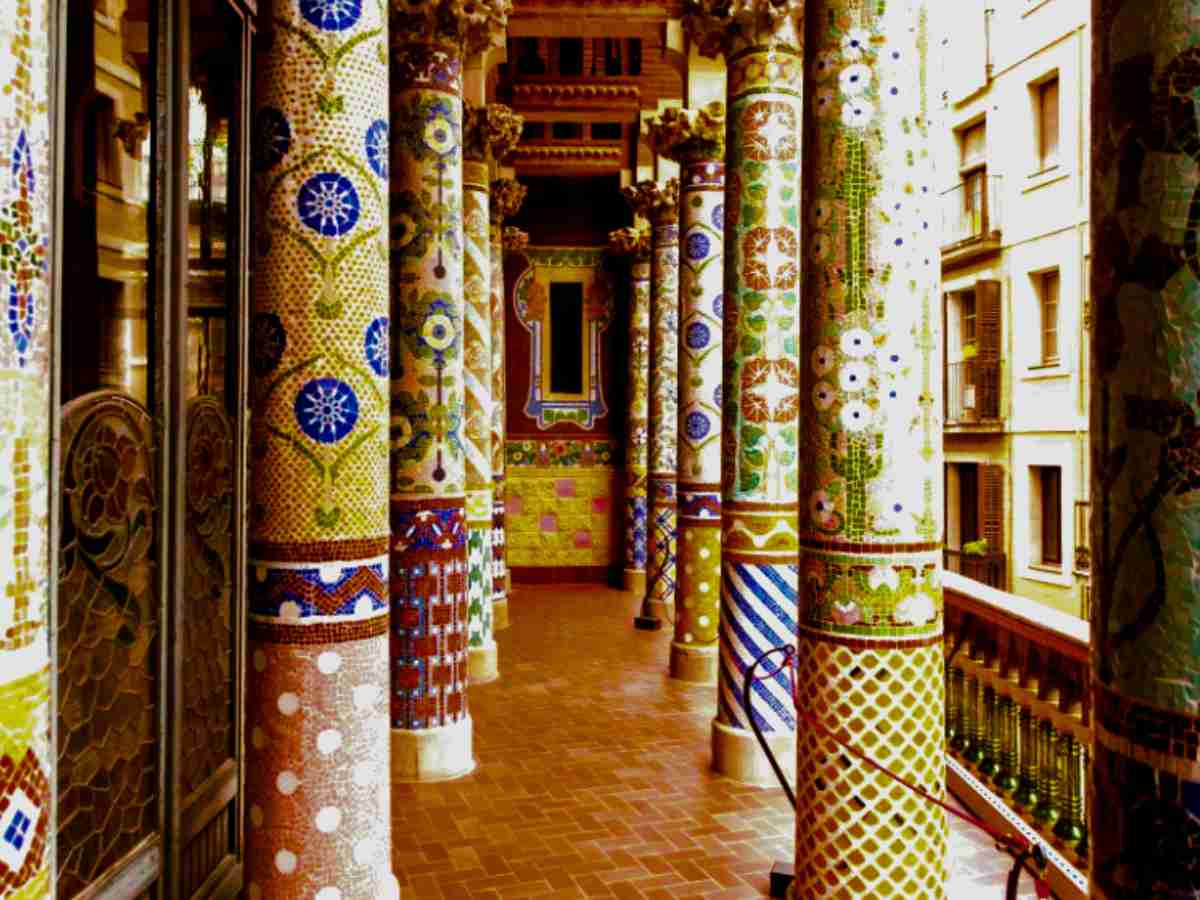
Basilica Santa Maria del Mar
Basilica Santa Maria del Mar is one of the nicest church to visit in Barcelona. A Gothic church built in the 14th century, this basilica is located in the El Born neighbourhood. It took fifty-five years to construct this basilica and was partly funded by the church members themselves.
The Basilica Santa Maria del Mar is famous for its magnificent Catalan architecture, a rare design as most basilicas in Catalonia have a mixture of styles.
Tips and Suggestions:
It does not take very long to see the church, about 15 minutes. If you have more time, select to join one of the guided tours which offers access to the rooftop The views over the square and the Old City are outstanding.
Open: 09:00 — 13:00 and from 17:00 — 20:30 daily.
Add: Plaça de Santa Maria, 1, 08003 Barcelona, Spain
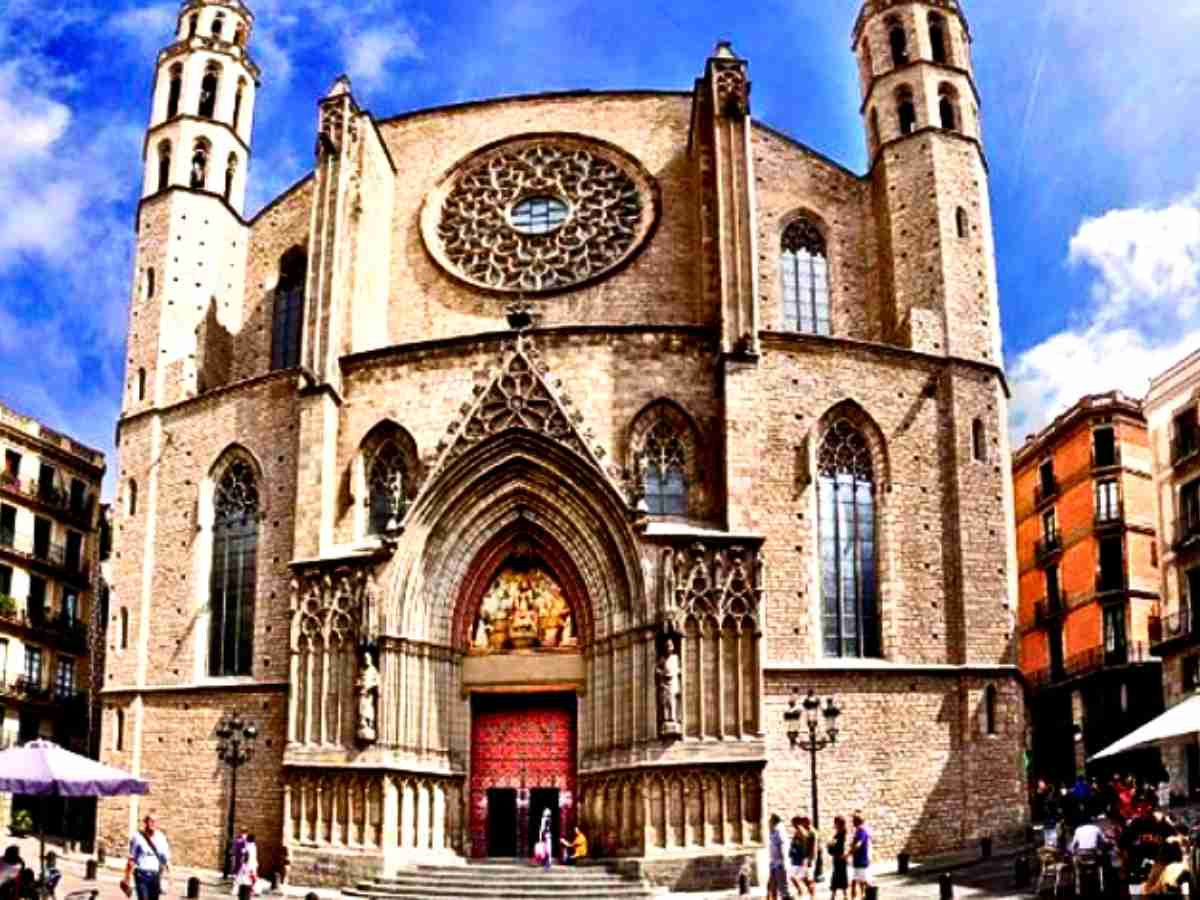
The Museu Picasso (Picasso Museum)
The Picasso Museum is a perfect place for art lovers to spend some time visiting Barcelona in the winter. One of the most visited museums in Barcelona is well worth a visit as it exhibits one of the largest collections of Picasso’s work across five adjoining medieval palaces. This is the only museum that was created during his lifetime. However, one thing you should know is that the collection displayed mainly dates from his early years as an artist and you may not see some of his famous works.
Picasso was born in Malaga and spent most of his formative years in Barcelona. He considered Barcelona his home. To honour his connection to Barcelona, the Picasson Museum houses an extensive collection of over 4,250 of his works. All of his works are exhibited chronologically. You can appreciate the evolution of his art, from a traditional style to a more unconventional style that Picasso is known for.
It is really interesting to see how Picasso developed as an artist and how his style changed over the years.
Suggestions and Tips:
PRO TIP: The Picasso Museum in Barcelona offers free admission on certain days and at certain times. At the time of writing, free admission is available on every first Sunday of the month from 09:00 to 19:00. as well as every Thursday evening from 18:00 to 21:30.
At any other time, you may want to pre-book this skip-the-line access to the Picasso Museum or you could visit the museum as part of the guided Barcelona city walking tour.
Add. Carrer Montcada, 15-23, 08003 Barcelona Spain.
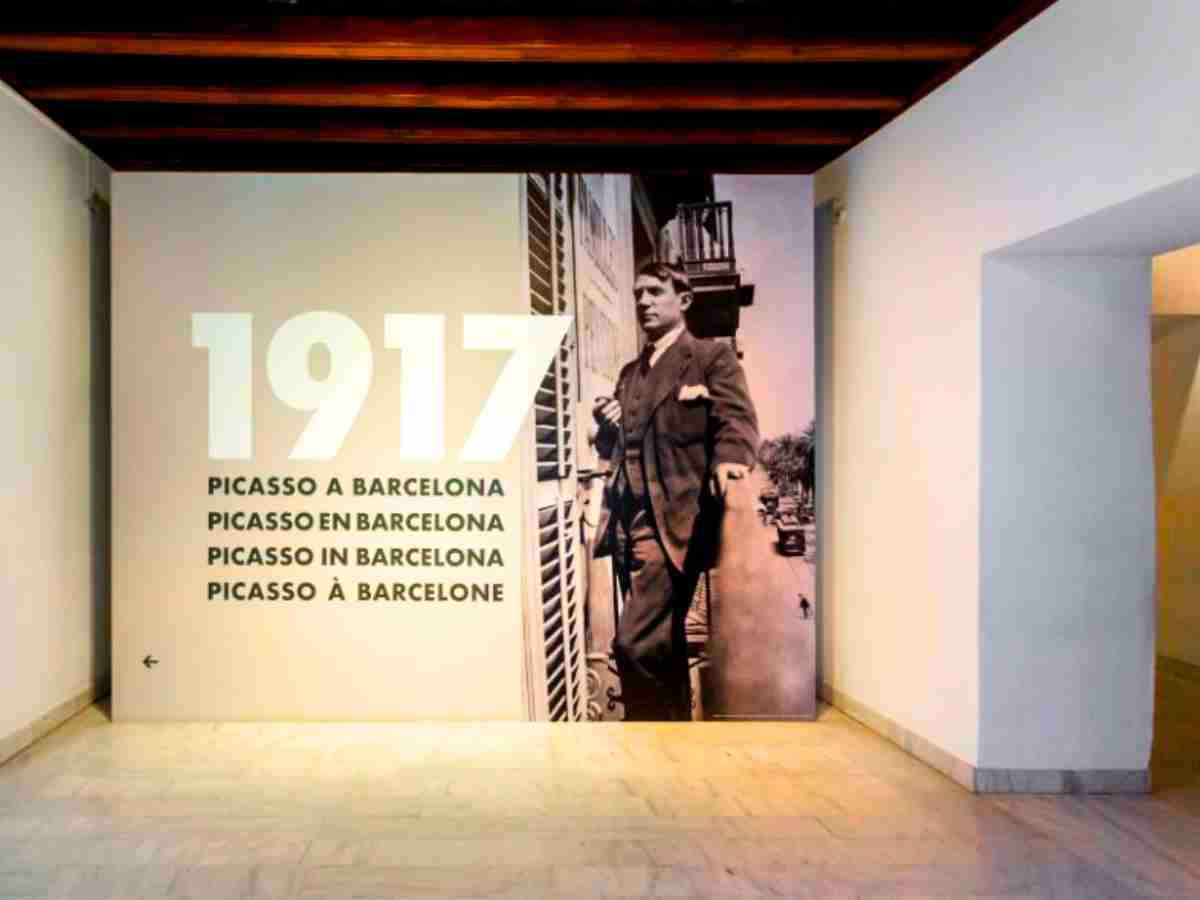
History Museum of Barcelona (MUHBA)
The History Museum of Barcelona is one of the most interesting museums in the city and is one of the best things to do when visiting Barcelona in the winter. Here, you can witness the archaeological remains of streets and buildings from 2000 years ago.
Situated in Placa del Rei, just to the rear of Barcelona Cathedral, this intriguing museum is dedicated to preserving the city’s history and is home to more than 35,000 historical and cultural artefacts.
Good to know before visiting the History Museum of Barcelona in the Winter
Audio guides are included in the ticket price which allows admission to all of the MUHBA sites in the city. You can find out more information about the museum and the other sites from their official website of History Museum of Barcelona (MUHBA).
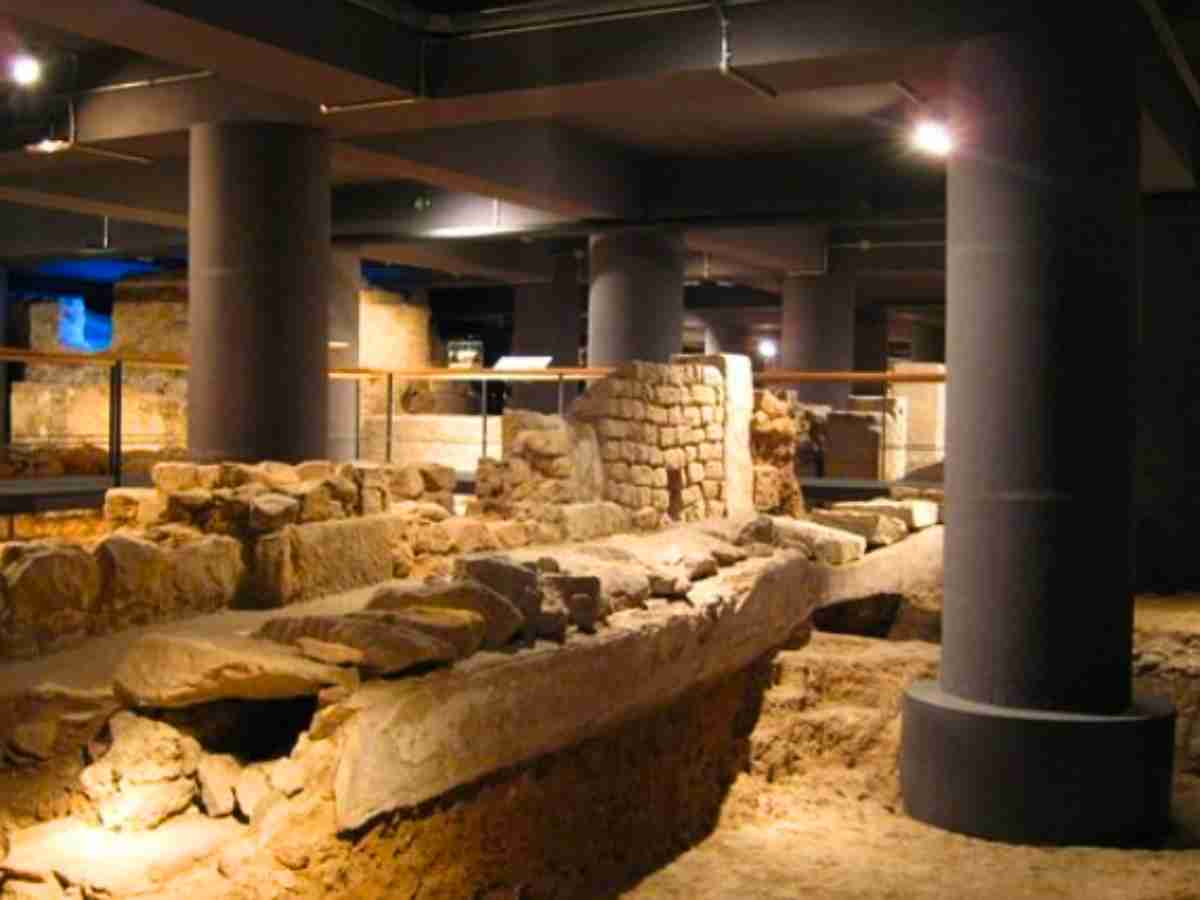
Port Vell and the Waterfront, Barcelona in the Winter Months
Port Vell, the Old Harbour of Barcelona, and recently completely restored is one of the most picturesque sights in the city. No visit to Barcelona is complete without a walk along its pedestrianised promenade dotted with palm trees. It is really nice to take a stroll and admire the yachts and boats moored here. It is a popular area for both the locals and tourists.
Port Vell is a bustling area with lots of cafes and restaurants. You will also find the History Museum of Catalonia situated here as well as the Barcelona Maritime Museum.
What to look out for at Port Vell and the Waterfront:
Look out for Rambla De Mar, a modern walkway that connects the end of La Rambla from the Columbus Monument to the Old Harbour and the Maremagnum area.
Barcelona Aquarium, one the city’s many family-oriented attractions makes for a great day out in Barcelona in the winter. It houses twenty large tanks of Mediterranean habitat. The main attraction is the Oceanarium, a huge deep tank that allows for an up close and personal view of sharks and manta rays.
One of the most interesting features dotted along the quayside is a diverse collection of contemporary statues. My favourite is one of The Couple (La Parella in Catalan) by the Chilean artist Lautaro Diaz Silva. The slender figures have no arms but the male clearly holds his partner and they sit, with gaze fixed out to sea.
Suggestions and Tips for Port Vell + Waterfront
TIP: Why not get a different perspective of Barcelona in the winter? Take a boat tour in a small traditional style boat or in a modern glass-bottom boat that leaves the port and cruises along the coast.
Boat tours can take up to forty-minutes and it is one of the best things to do in Barcelona. There are several other boat tours available also: electrically powered Eco-tours, catamaran cruises and sunset sailing cruises. If you decide to experience any of these tours, it is always best to book in advance of your travel.
PRO TIP: For timeless experience, stay at the luxury Hotel W Barcelona situated here with spellbinding views of Barcelona’s beach, and the beautiful coastline.
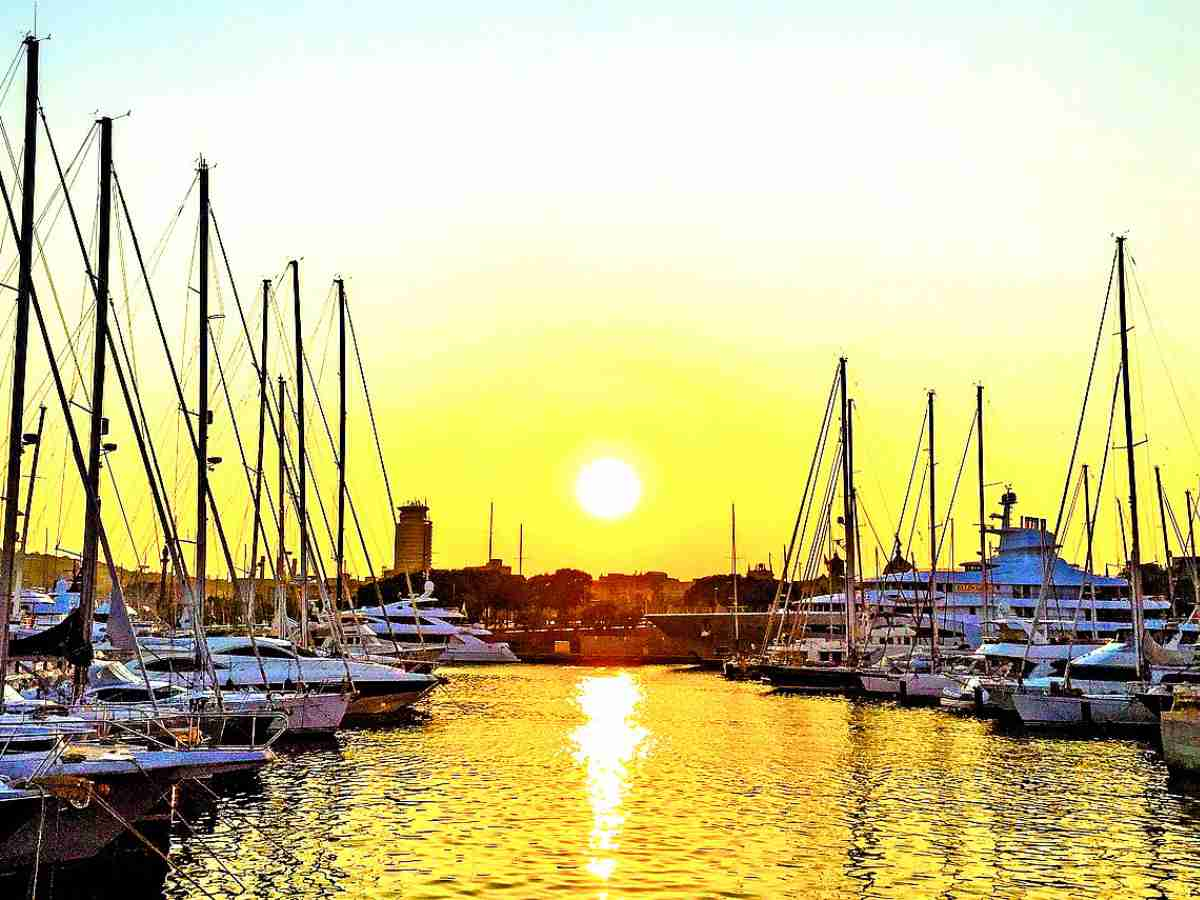
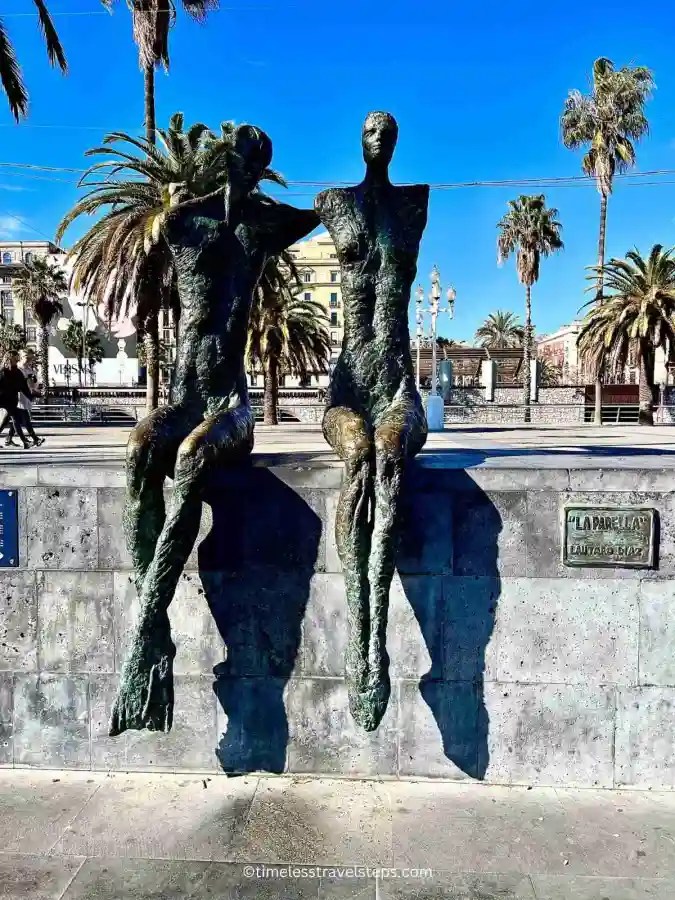
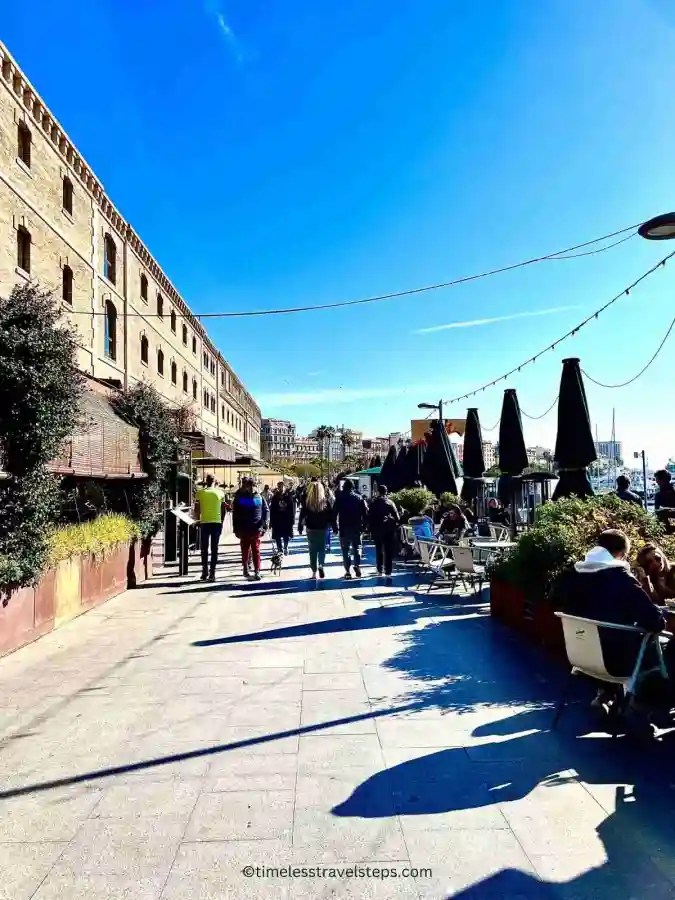
The Christopher Columbus Monument
Columbus Monument (Mirador de Colom in Catalan), dedicated to the famed explorer of the “New World” was erected in 1888. The iron column stands at 60m high and is topped with a bronze statue of the Italian explorer, portrayed as holding nautical charts and pointing out to the sea. The base of the column is made of stone and is decorated with statues.
Suggestions and Tips:
On your visit to Barcelona in the winter, take the elevator from the base of the tower to reach the viewing gallery just below the statue’s feet. The glassed-in gallery affords panoramic views of the Gothic Quarter, La Rambla, Port Vell and The Montjuïc mountain.
There are eight impressive statues of lions on the base of the monument which makes a great backdrop for photos.
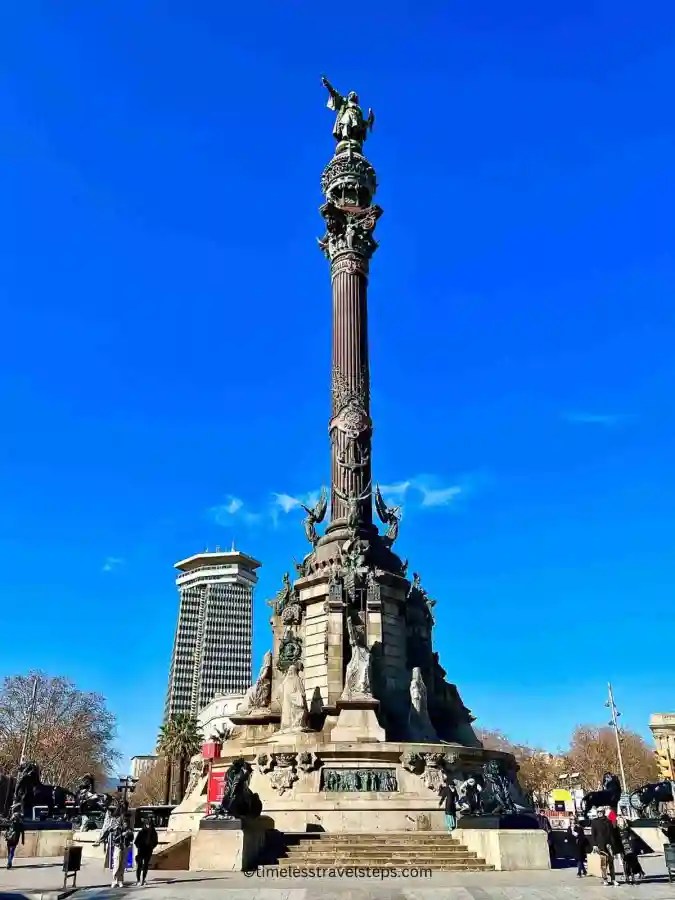
Barcelona Beaches in the Winter
Barcelona has miles of scenic coastline that beckons a visit, even for a short while during a winter getaway. These sandy beaches are only about 10 minutes walk away from La Rambla.
There are four beaches here: Barceloneta; Mar Bella; Icària Beach and Sitges Beach. All of these beaches are reputed to be busy with locals and tourists alike.
When we visited Barcelona in the winter, the sun was shining bright and the winter warmth was soft and uplifting. Barceloneta beach was not busy. There were people swimming and some sunbathing. It was perfect for unwinding with a book or to catch a sunset.
Suggestions and Tips:
TIP: Barceloneta Beach is reputed for its vibrant nightlife and a party atmosphere. If you are looking to connect with like-minded travellers, this would be a great place to meet others from all over the world.
For a family-friendly beach, try Icària Beach. It has plenty of sports activities and restaurants.
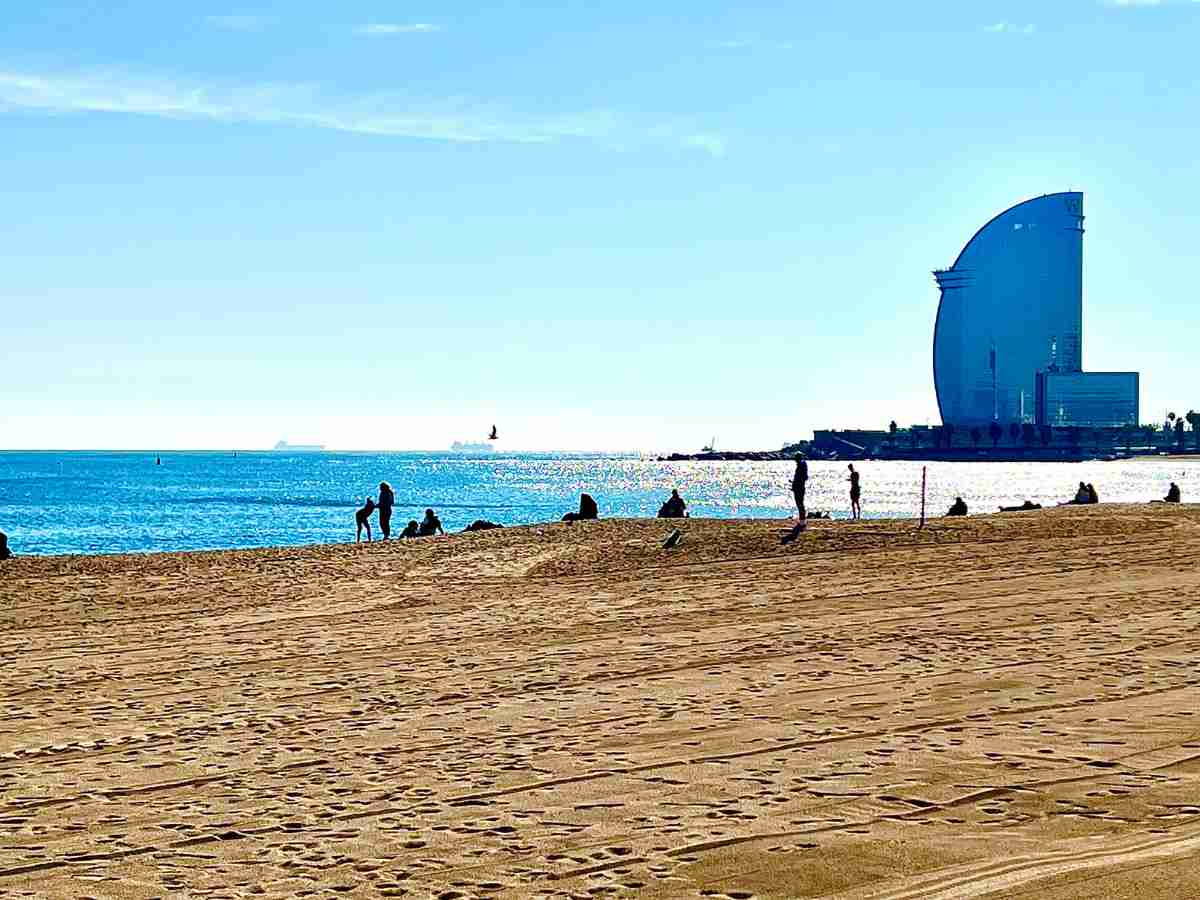
The Montjuïc Mountain in Barcelona on a Winter Visit
Located right next to the sea, the Montjuïc Mountain is another beautiful place in Barcelona not to miss. It is best described as one huge park sprawling over the entire hill where some parts are more special than others. This famous hill in Barcelona is home to several museums, parks and gardens, pavilions and viewpoints, all built for the 1929 Internationa Fair.
Montjuïc, meaning “Jewish Mountain” in Catalan was once home to a Jewish community. This scenic wooded hill rises to 173m above sea level and is situated between Placa Espanya and the Old Harbour.
What to look out for at Montjuic Hill
Montjuïc Cable Car: Visitors to Montjuïc come here primarily for the scenic views of Barcelona’s harbour from the cable car. The cable car is also a good mode of transport if you want to save time and avoid climbing the hill. You can book your return ride on the cable car here.
The Magic Fountain (Font Magica): An impressive water fountain that spurts to the tune of classical music, especially enchanting in the evening when it is lit up.
Visit the Palau Nacional, majestic palace which is now home to the National Museum of Catalan Art;
Poble Espanyol (Spanish Town), an open-air museum showcasing the various architectural styles found in the Spanish regions. This is a very popular tourist attraction.
Joan Miro Museum: Joan Miro, celebrated as a true Catalan artist embraced bold abstract paintings and sculptures. This vast museum exhibits 14,000 pieces of his work. A must-visit for all enthusiasts of 20th century art.
Visit also the Montjuïc Castle and Jardi Botanical Garden, situated next to the castle. The castle is not a glamorous attraction but is one of the highlights of this hill. The views over Barcelona harbour from the castle are spectacular.
Suggestions and Tips:
While there is a walking route from Placa Catalunya to Montjuïc, the most favoured way to reach the top of the hill is to take the funicular from the waterfront or by hop-on-hop-off tourist bus. You save some time by doing so. However, if you do want the walking experience, you could do the walk down which is much easier.
TIP: There’s a lot to see at Montjuïc that may take a good part of a day. The area is vast and can be overwhelming. If you don’t have much time, you could visit Montjuïc with a local tour guide. The guide knows exactly where to go and what to see and ensure you do not miss any of the highlights. With this particular walking tour that includes a cable car ride, you don’t have to wander around and can experience Montjuïc efficiently in a couple of hours.
Another fun way to experience Montjuïc is by joining an e-bike tour. There is more information here about this adventurous activity.
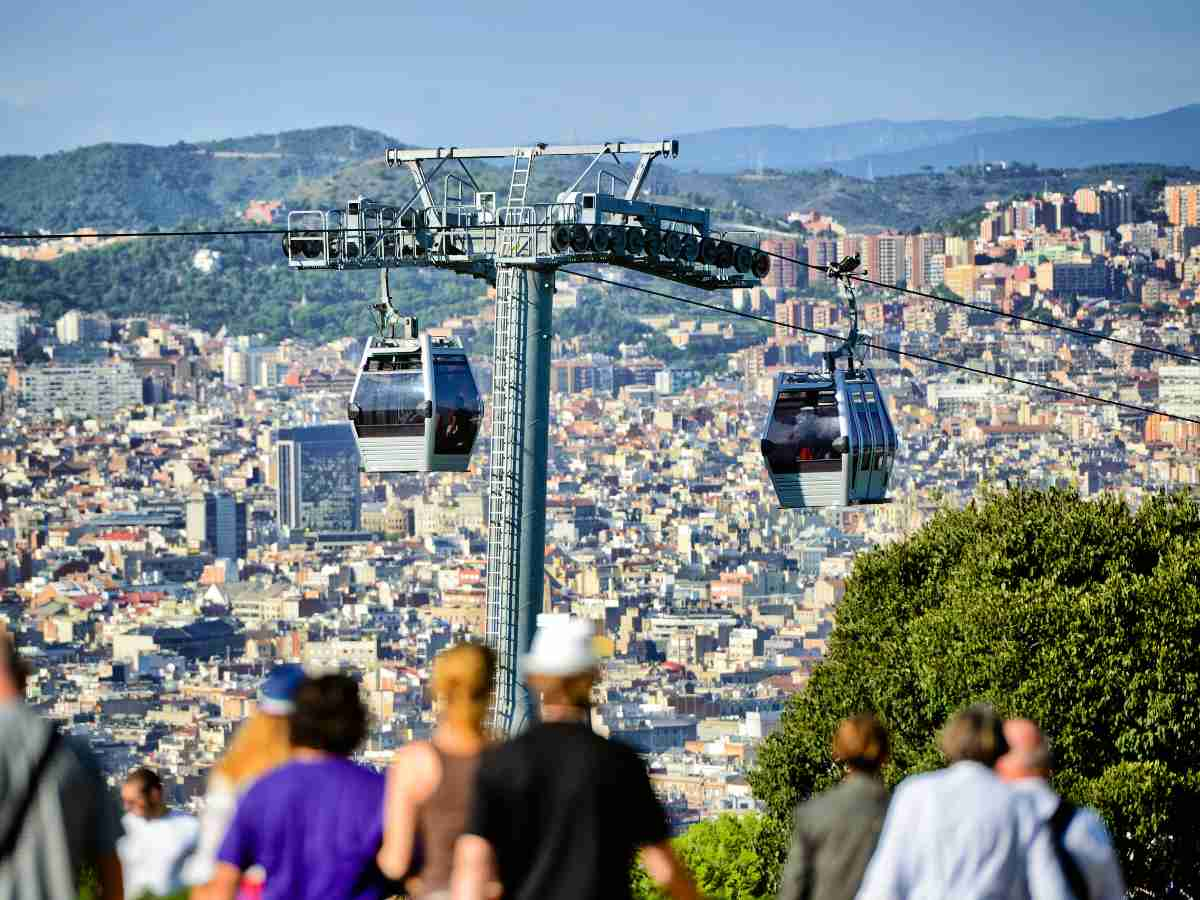
Camp Nou: F.C. Barcelona Stadium
Camp Nou is the home stadium of the world famous F.C. Barcelona: a must-visit for all football fans. This stunning stadium is the largest in Europe and is one of the most visited tourist attractions.
Tours of Camp Nou takes you to the pitch, the stands, the players bench, the changing rooms and the press area. A visit to the museum is also included, where you can learn more about the club and see their trophies.
Good to know before you go to Camp Nou:
Camp Nou is located in the Les Corts district, a little out of town. You can take the bus, metro or taxi from a central point in Barcelona.
You could take the metro from Placa Catalunya, which is a convenient central point in the city. Take the Green Line, L3 from Placa Catalunya and get off at Barcelona Sants. At Barcelona Sants, board the Blue Line, L5 and disembark at Collblanc. From collblanc, it is approximately a 20-minute walk via Carrer del Cardenal Reig to Camp Nou.
Suggestions and Tips for Camp Nou:
You could use BCN Card which gives you unlimited travel on the Barcelona public transport system including metro and buses.
The hop-on-hop-off bus also stops here. This may be a better option for you if you do not want the inconvenience of changing metro lines and walking for 20 minutes.
TIP: There are several ticket and tour options for a visit to Camp Nou. The most popular is the self-guided stadium and museum tour which gives you the flexibility to explore at your own pace. Another option is the guided tour, where you can learn lots more about the club’s history.
If you are looking for a timeless experience, you could opt for the special Players Experience Tour. This special tour includes all that is in the basic tour and in addition includes access to the actual Barcelona players locker rooms and an official FC Barcelona gift.
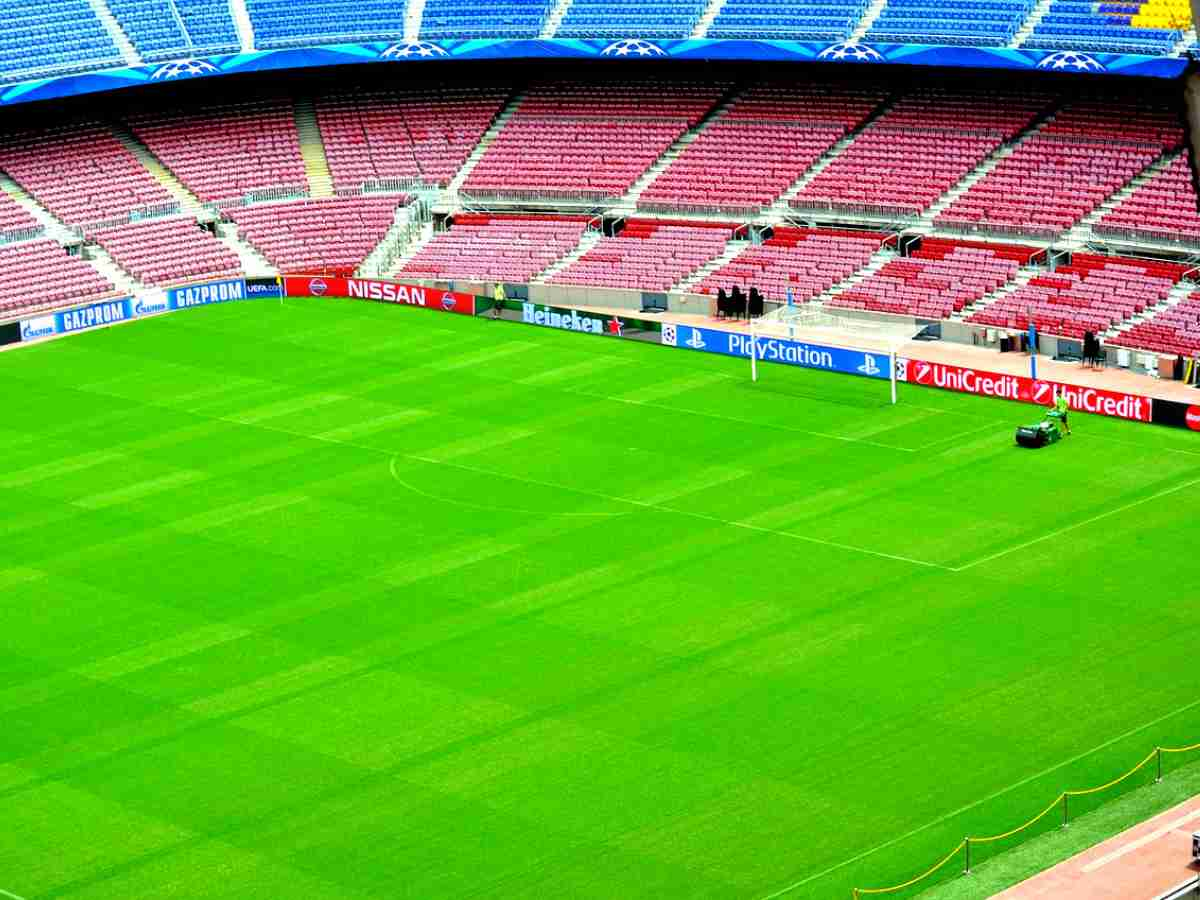
Monserrat Mountain Range
The Monserrat Mountain range is located about 50km northwest of Barcelona city centre. The journey by road is about an hour. The mountain range rises to 1200 meters above sea level.
The main attraction here is the Benedictine Monastery of Santa Maria de Monserrat, one of Catalonia’s most important religious sites. It sits on the Camino de Santiago pilgrims trail. While you cannot visit the Monastery itself, you have free access to the grounds, and the church. You can also hear the daily performances of the famous Monserrat boys choir.
The statue of Black Madonna, Catalonia’s patron saint, attracts most visitors. This can be a once-in-a-lifetime visit for pilgrims.
Hiking Trails
There are many hiking trails surrounding the monastery and you can enjoy incredible views of the landscape. The easiest trail, one that is clearly marked which you could try is the Walk to St Michael’s Cross. An uphill trail, it is steep in some areas and takes about half-an-hour to reach the cross. Returning is much easier and takes about twenty-minutes.
Take a look at this view from St Michael’s Cross of the Monserrat Monastery, the valley and the mountain range.
Good to know before you go to the Monserrat Mountains:
This is one of the main tourist attractions in Spain, therefore transport links to Monserrat are good. There are several ways you could reach this holy mountain: on your own by train, or by car or with one of the many day tours from the city.
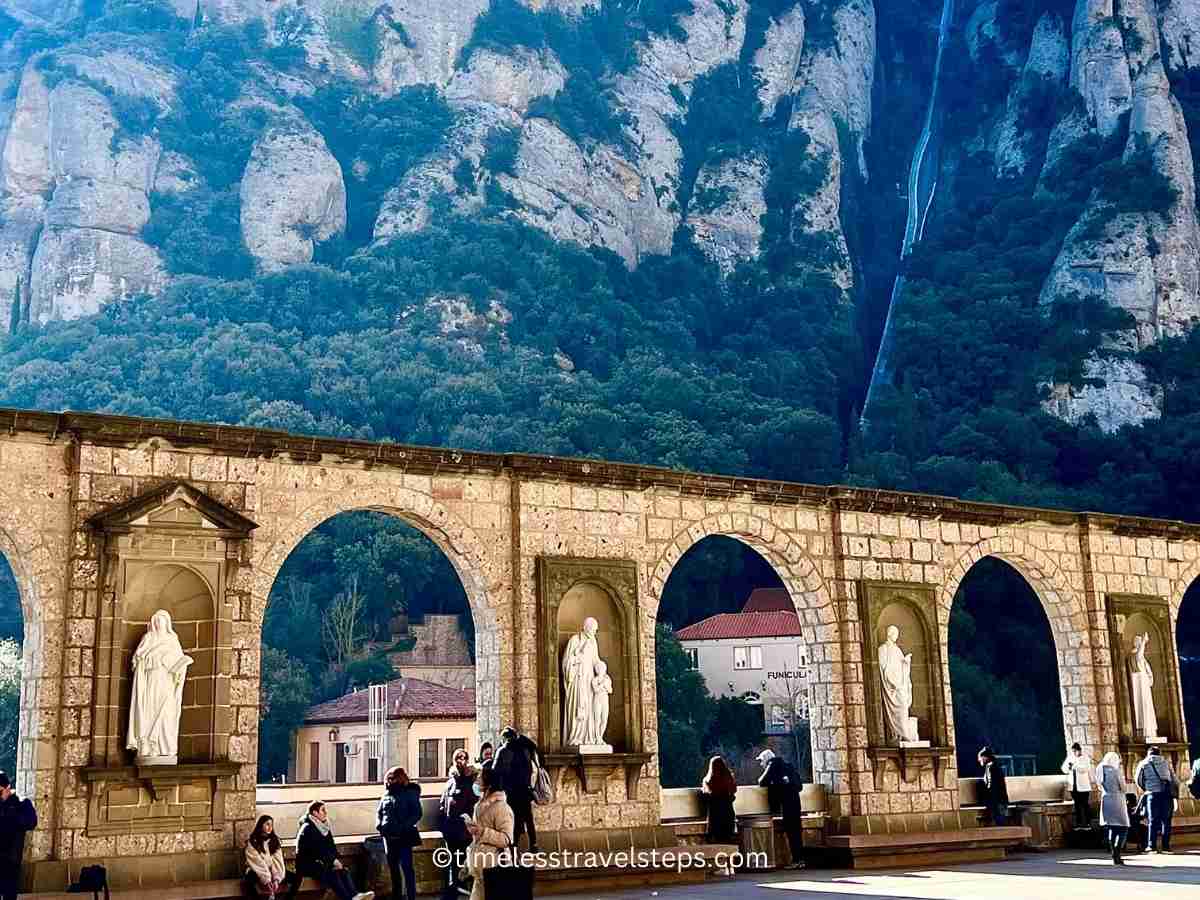
Additional Suggestions for Your Barcelona in the Winter Itinerary
In addition to the landmarks and best things to do in Barcelona mentioned above, there are many more activities to do and attractions to see in this grand city. A metropolis such as Barcelona, as one can imagine, offers much for family travel, couples travel as well as fun experiences for weekend getaways.
Take a look at the following great activities that are worth considering for timeless travel experiences. Even if you add one or two of these experiences, it will make your winter vacation in Barcelona really special:
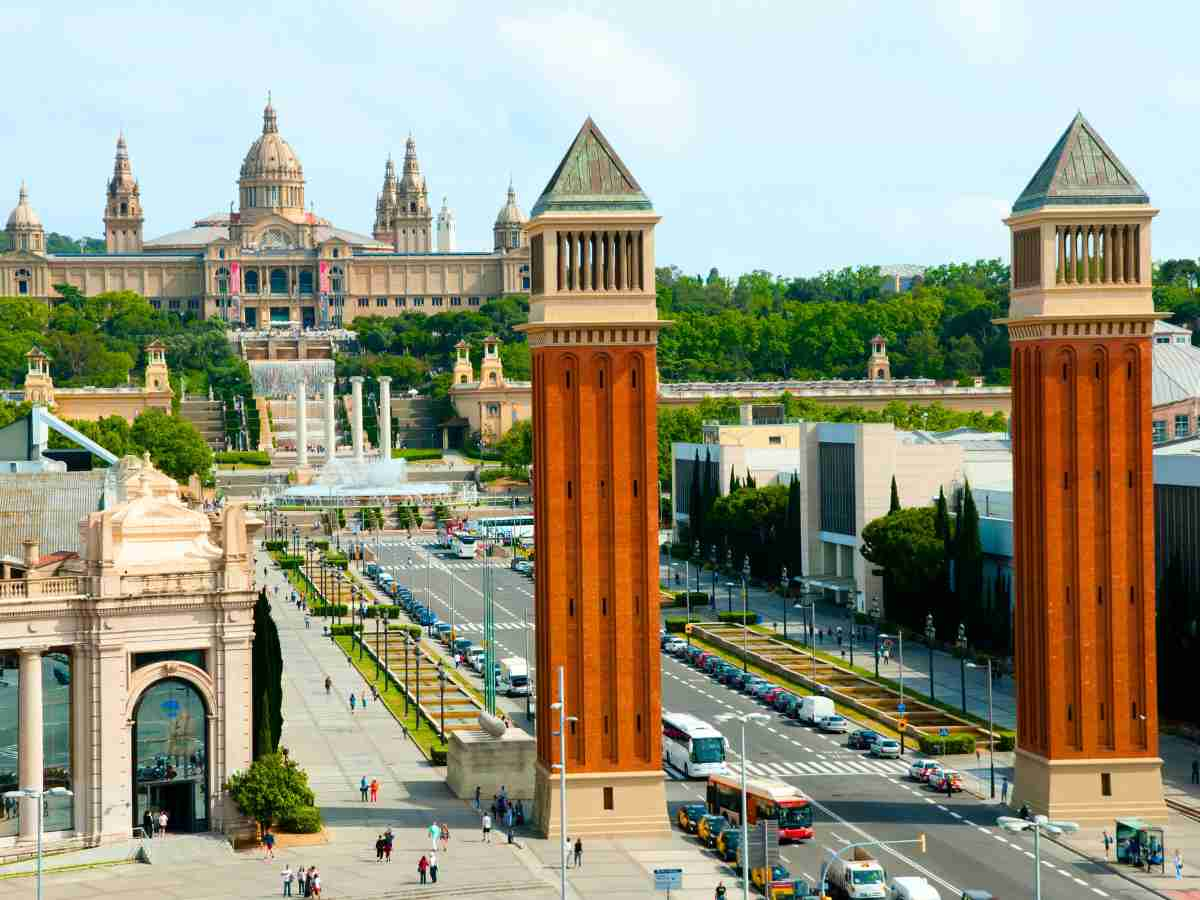
Adventure Experiences
Helicopter Ride: This activity combines a walking tour of the city, sailing along the coast of Barcelona and a helicopter ride, giving you a 360º experience of Barcelona.
Hot Air Balloon Flight: This is one very special way to see Catalonia’s countryside. This particular hot air balloon flight comes with snacks and drinks. You could also enjoy this quintessential experience in a small group for between four and six hours.
FAQs about Barcelona in Winter
Barcelona can be relatively mild in January compared to many other European cities, with daytime temperatures typically ranging from 10-15°C (50-59°F). However, it may feel chilly to some visitors, so it depends on your tolerance for cooler weather.
Compared to the summer months, Barcelona experiences fewer crowds in January, making it a less crowded time to visit popular attractions and enjoy a more relaxed atmosphere.
Barcelona can be considered a winter destination, especially for travellers looking to avoid extreme cold. While it may not have typical winter activities like skiing, it offers cultural events, mild weather, and lower prices during the winter months
Yes, Barcelona is generally milder and warmer than Madrid during the winter months. Barcelona’s coastal location and Mediterranean climate result in more moderate temperatures compared to the colder winters in Madrid.
Visiting Spain in winter can be worth it, depending on your preferences. It offers a more budget-friendly and less crowded experience compared to the peak summer season. While some regions may have cooler temperatures, Spain’s diverse culture, cuisine, and attractions are still enjoyable year-round.
finally…as the deliberate escapist and a mindful wanderer
This is my guide on the top landmarks, attractions and the very best things to do in Barcelona in the winter time for three to four days. In fact, regardless of whether you’re visiting during the summer or winter months, Barcelona has plenty of activities to keep you busy and entertained.
My sincere wish is that this guide has helped you to figure out what are the best things to do in Barcelona for your vacation during winter or at any other season.
Happy and Safe Travels, Wherever Travel Takes You, xx



